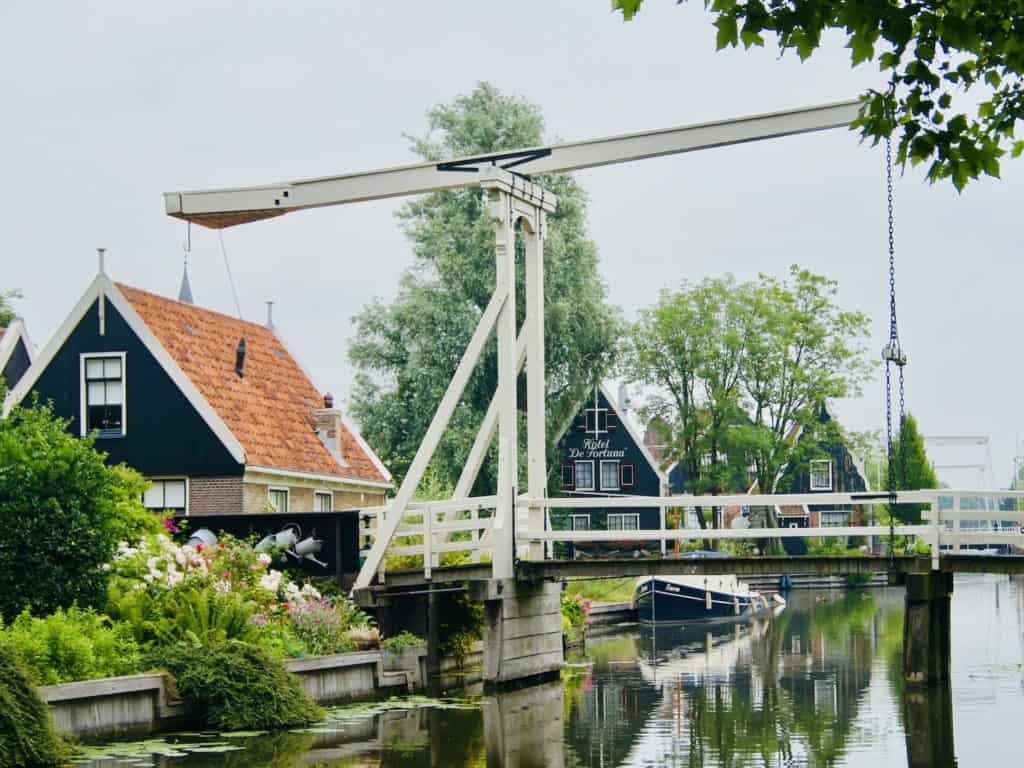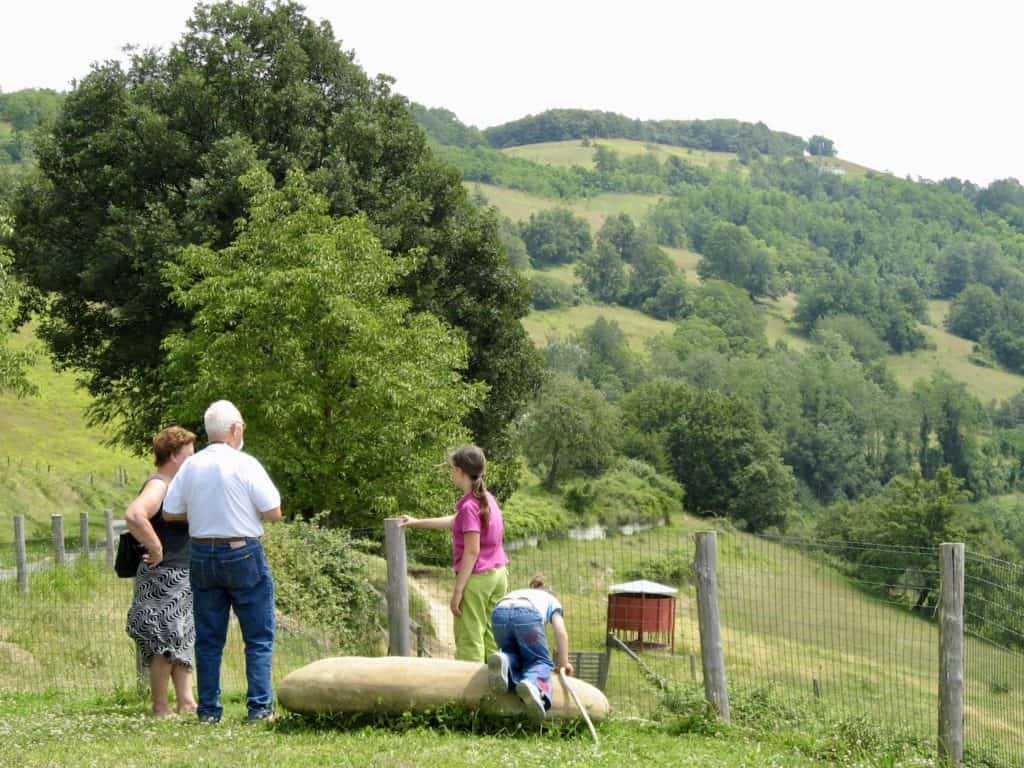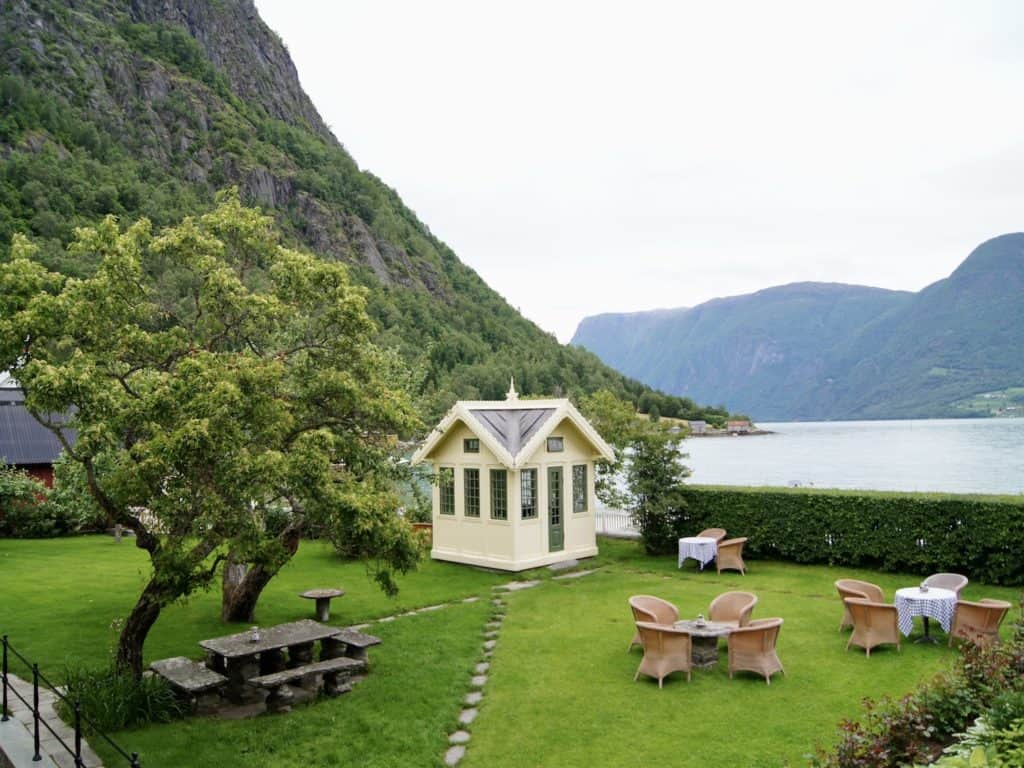Italy is one of the top five visited countries worldwide, and it’s easy to figure out why. It’s got gorgeous landscapes, rich history and culture, welcoming people, and amazing food and wine. Plus it is home to 54 World Heritage Sites, designated by UNESCO as sites with unique historic, physical, or cultural significance. Some of those Italian sites are the historic centers of Piedmont, Cinque Terre, Portofino, Florence, Siena, Rome, Vatican City, Naples, Sorrento, Pompeii, Amalfi Coast, Paestum, Matera, seaside Vista, Alberobello, and Sicily — all highlighted in this article and places (my husband and) I recommend others to visit.
Note: This post was most recently updated in January 2024.
TIP: Take advantage of the Tourist Information (TI) offices in the towns you visit. Knowledgeable locals usually staff the offices and can recommend great spots to visit — plus tell you how to get there. An example from one of our trips to Italy stands out. A quick visit to a TI helped us figure out what to do one day when we had plans to hike the Cinque Terre but couldn’t get there because of a train strike. The solution: take a local bus and then a boat to Portofino for the day. Now that’s making lemonade out of lemons. We had a lovely and unexpected visit to that beautiful fishing village and were able to hike the Cinque Terre the following day.
Northern Italy: Piedmont
In northwestern Italy, Piedmont is a region that boasts the Barolo and Barbaresco wine regions, Turin, and a variety of small towns and villages. We stayed in a gorgeous renovated castle from the 12th century. A good base while exploring the area (wineries, agriturismos, farms, shops) is Castello di Sinio, which is one of those places that will stay with you long after you leave — the accommodations and the hospitality are stellar.
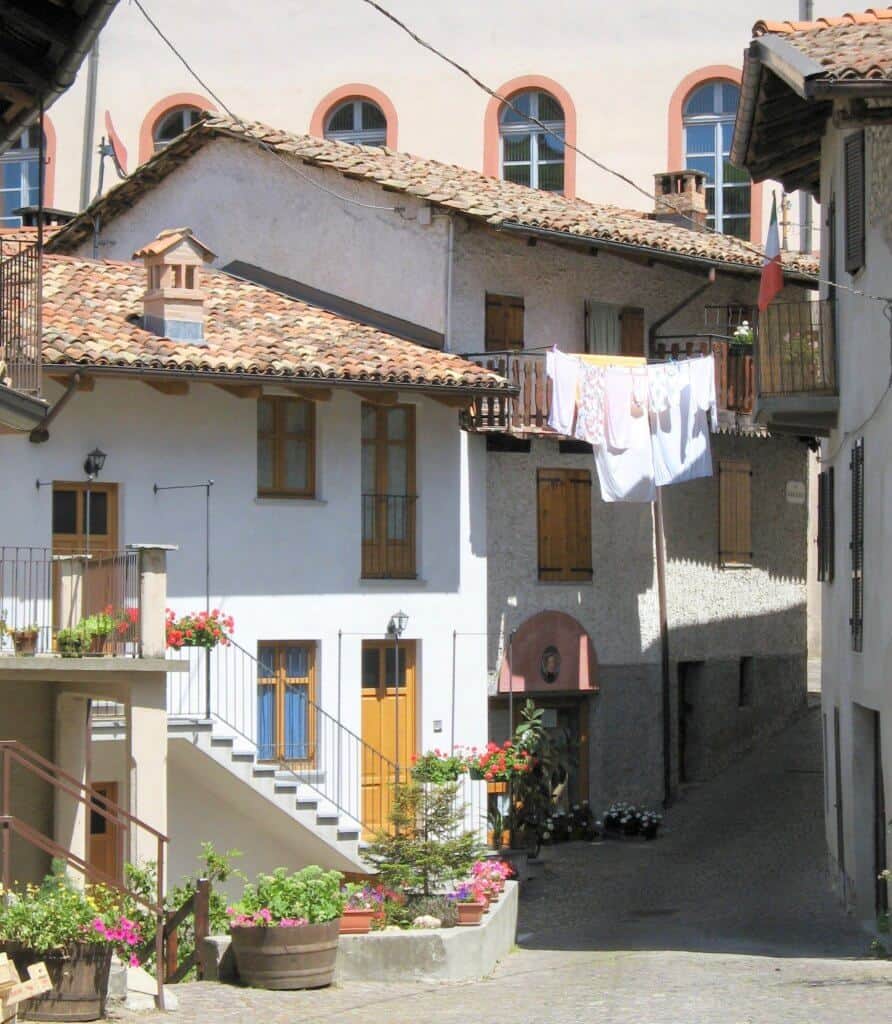
Sinio, a Piedmont Village
A walk around Sinio (which we enjoyed while staying at the charming Castello di Sinio) gives visitors a peek at everyday life in this small, charming village of less than 1000 folks.
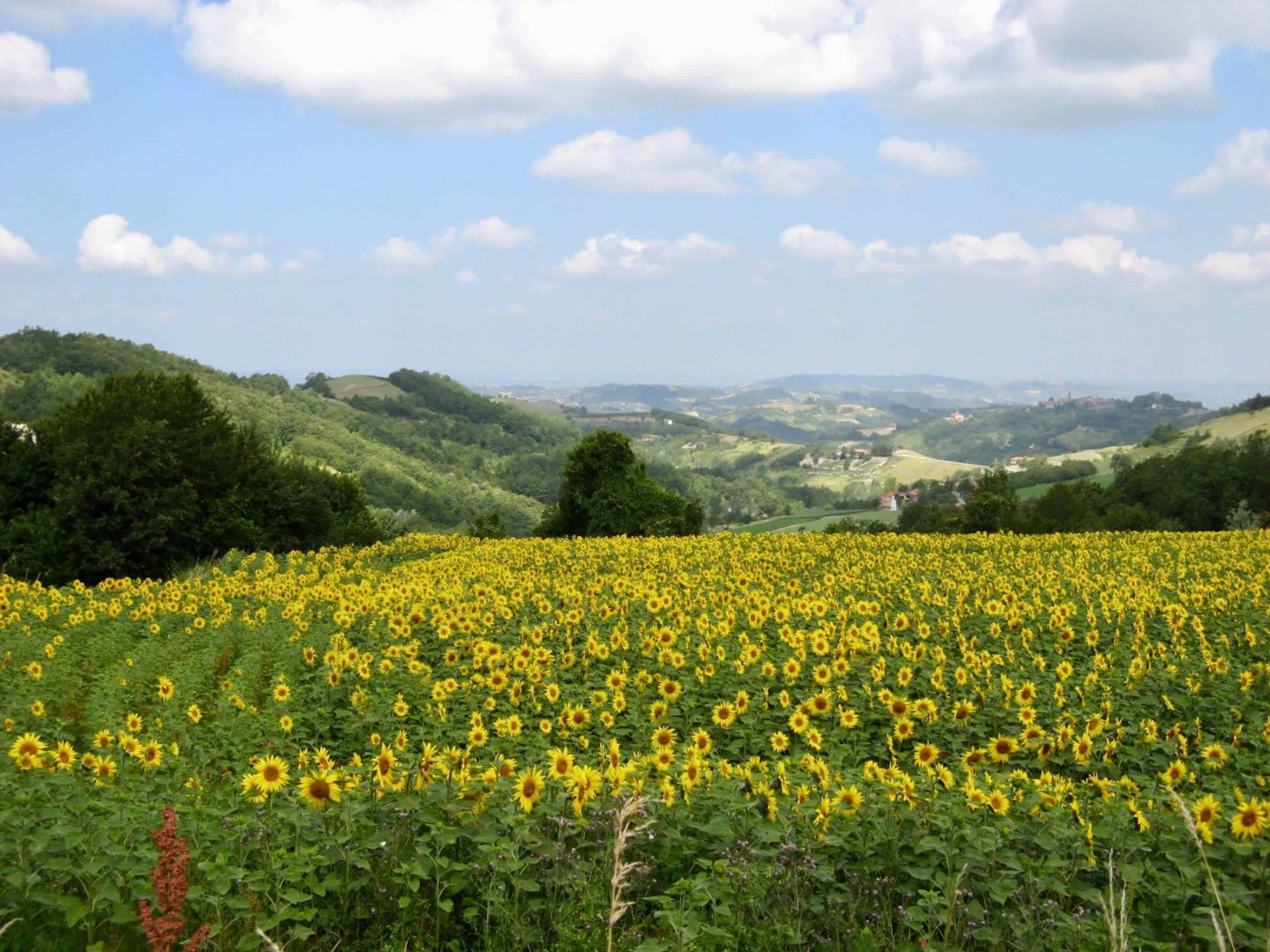
Northwestern Coastal Italy: Cinque Terre
We stayed in Sestri Levante, making visiting the Cinque Terre (“Five Lands”), Portovenere, and Portofino easy. Cinque Terre was clearly a highlight for us as we walked the entire length from Monterosso al Mare in the north, through Vernazza, Corniglia, Manarola, and then to Riomaggiore (the southernmost town that’s part of the Cinque Terre). Although it was a long day, it was an awe-inspiring trek along a centuries-old goat path on the side of a mountain connecting the five towns. All the while, the hike offered up spectacular views of the mountain on our left and the glistening sea to the right.
Access the Cinque Terre by foot or train only; cars are not allowed. (We actually had to delay our adventure one day because the trains were not running due to a strike on the day we chose for our hike, so we couldn’t reach our intended starting destination. That’s the day we headed to Portofino.) We broke up our day-long hike with a relaxing lunch in one of the towns along the way. We chose a cafe in Manarola, which was perfect for us, but we could have chosen any of these towns and been perfectly happy.


Northwestern Coastal Italy: Portofino
From Sestri Levante, we traveled to Portofino. (When we visited, the trains were on strike, so we took a city bus — a unique experience — and then a boat to the Portofino harbor. It was all worth it!) We hiked up the path from the port to take in the harbor’s beauty from a higher elevation. Portofino is a place just to relax and enjoy a glass of wine outside while watching citizens catch up with each other, viewing the boats coming and going, and just reflecting on the easy-going Italian way of life.
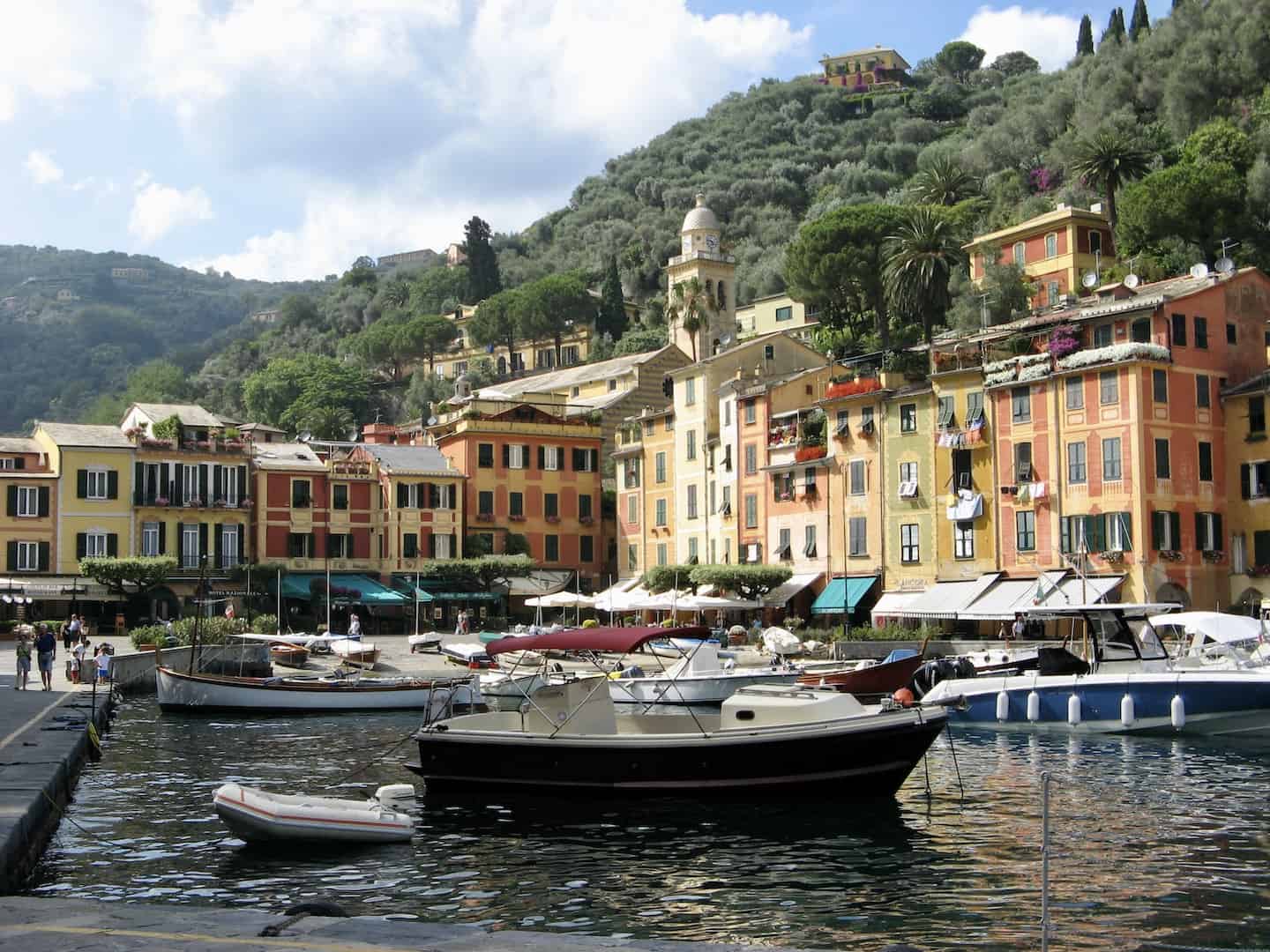

Northwestern Coastal Italy: Portovenere
As we did on our trip to Portofino, we took a boat from the Cinque Terre to the lovely Portovenere (the port of Venus) south of the Cinque Terre, admiring the rugged coastline from the water. San Pietro (a church built in the 13th century to honor the patron saint of fishermen) and San Lorenzo (another 13th-century church) are worth visiting for their history and art. We also enjoyed lollygagging by the water and enjoying the beautiful summer day at an outdoor cafe. Sometimes, you need to slow down, relax, and take in the beauty around you.
Tuscany: Florence
Florence (Firenze in Italian) was the center of finance, trade, politics, the arts, and culture in the Middle Ages. In addition, it is often considered the birthplace of the Renaissance. Florence was incredibly influential on regions around it. Today, Florence continues to marvel as tourists flock to this city that boasts so much history, art, and culture.
Florence exceeded our expectations. The history, the charm, and the decade-after-decade commitment to preservation. Outstanding! It’s hard to do Florence justice, so please find a way to visit and experience this one-of-a-kind city yourself. By the way, we enjoyed a fantastic week at an Italian cooking school, Casa Ombuto, in a magical setting about an hour’s drive from Florence (and I highly recommend that experience).
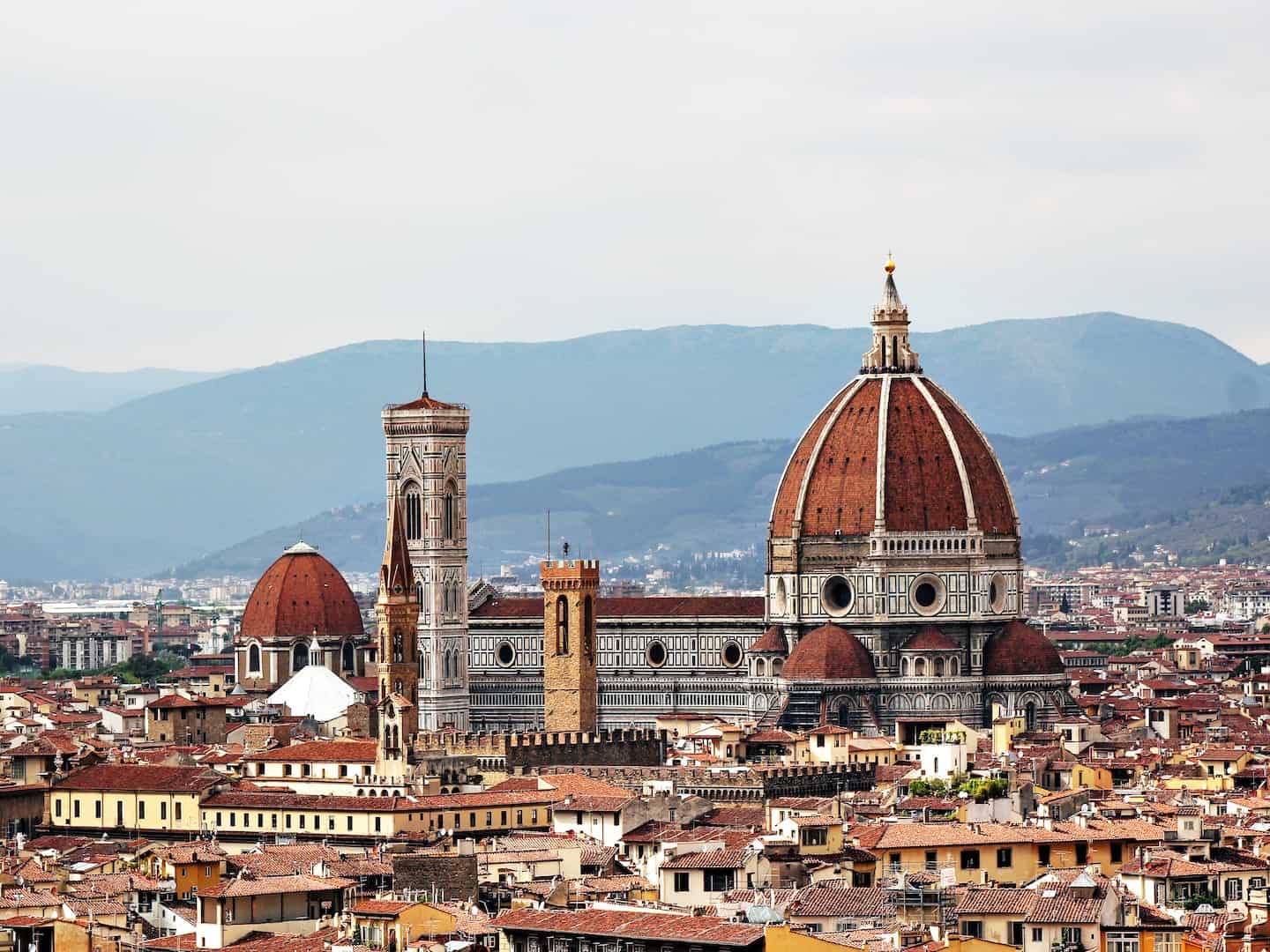
Florence Highlights
- Our half-day walking tour was an efficient way of being formally introduced to Florence. It immediately established our “Florence sea legs.”
- Visiting the Florence Cathedral, formally the Cattedrale di Santa Maria del Fiore, is the Duomo (or cathedral) of Florence, Italy. It began in 1296 in the Gothic style and was structurally completed by 1436. The dome was built from a design created by Florentine architect and engineer Filippo Brunelleschi that won a public competition. This was no easy feat because people of the day had to design a dome that spanned 150 feet and began 180 feet above the ground. Brunelleschi figured it out, and he is forever remembered for this work. He is entombed in the Duomo. TIP: You can buy a cumulative ticket to access the Duomo and the Baptistery.
- Walking up the inside of the Duomo! We walked up on an interior path between the inner and outer shells of the dome. At the top, we could step inside the dome on a platform. From there, we gazed up at the magnificent artwork and down at the altar. Another treat was stepping outside at the very top of the dome. From such a height, we could see over the rooftops of the sprawling city below. Plan on doing this early in the morning while it’s still cool and before the rest of the tourists arrive. Reservations to access the dome are mandatory.
- Viewing the bronze doors of the Florence Baptistery, also known as the Baptistery of Saint John, which is next to the Duomo. The doors depict biblical scenes and were designed by Florentine Lorenzo Ghiberti in the 15th century after winning a public competition to do so.
- Spending hours exploring the Uffizi Gallery, a prominent art museum housing art from the 14th-16th centuries, located adjacent to the Piazza della Signoria. The Italian and Florentine (and other European) paintings and sculpture treasures inside are available to view, thanks to the influential Medici family who bequeathed them to the city.
- Walking to the Ponte Vecchio, a medieval stone closed-spandrel segmental arch bridge over the Arno River, noted for still having shops built along it, as was once common. Butchers initially occupied the shops; the present tenants are jewelers, art dealers, and souvenir sellers. The Ponte Vecchio is one of the landmarks, along with the Duomo, that dominates a lot of images and postcards of Florence.
- Gazing up and walking around the copy of Michelangelo’s David statue as well as others in the Accademia Gallery. David stands about 17 feet high, was carved from Tuscan marble, and shows him before his iconic fight with Goliath. Michelangelo was in his 20’s when he began this masterpiece. (You can easily gain admission as part of a walking tour.)
- Visiting the Piazzale Michelangelo, a square with a panoramic view of Florence, located in the Oltrarno district of the city.
Tuscany: San Gimignano & Other Hill Towns
Sometimes referred to as “Medieval Manhattan,” San Gimignano has 14 stone towers that populate this small hill town. They were erected by competing families who lived here and were used partly for defense. This, along with other hill towns of Cortona, Montepulciano, and Volterra, is worth a brief visit when driving through the area.
Tuscany: Siena
Our favorite hill town is Siena. When you drive through the gates of the medieval wall surrounding the old town, you feel like you have instantly stepped back to the Renaissance. Every narrow street (mostly pedestrian only) suggests that the past is being painstakingly preserved for your benefit. That feeling is highly concentrated since Siena is also significantly smaller than Florence (its Middle Ages-Renaissance arch-rival).
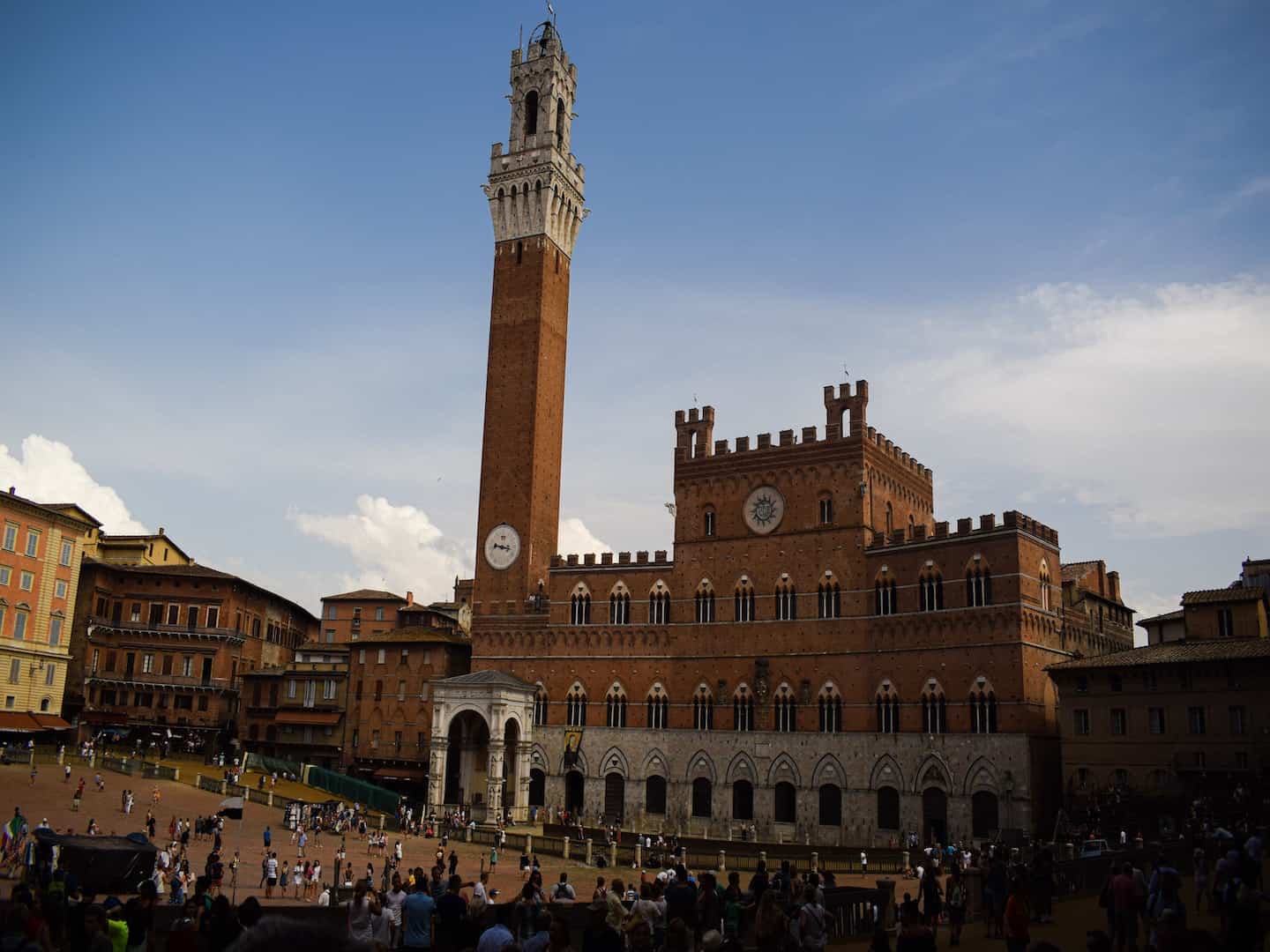
Siena Highlights
- Strolling through town and people-watching while enjoying some refreshment at one of the many cafes lining the Piazza del Campo. This is where the action is: the square with its fountain (Fonte Gaia), the tower (Torre del Mangia), and the city hall (Palazzo Pubblico) where you can view the famous frescoes Allegory of Good and Bad Government.
- Enjoying a view of the Fonte Gaia, a huge fountain located in the Piazza del Campo and fed by underground pipes brought water to the site about 15 miles away.
- Climbing the more than 400 stairs of The Torre del Mangia, a tower built in the mid-14th century and located in the Piazza del Campo, to view Siena and the surrounding countryside. Perched so high, we tried to visualize town life centuries ago as we peered over rooftops, across to the Duomo, and down into the square.
- Visiting the Duomo di Siena with its most impressive facade and an interior that makes great use of white and black marble in a striped motif and impressive artwork when you gaze skyward. Works by Michelangelo, Pisano, Bernini, Duccio, and Donatello are showcased here.
- Imagining the twice-annual neighborhood horse race (on July 2 and August 16) that is run in the Piazza del Campo. We were a few weeks early when we visited, but we heard just how central it is to the town. The bareback horse race has been going on for centuries with riders from each of the town’s districts vying for the hand-painted banner that is awarded to the victor. Quite a bit of pageantry precedes the race that is run inside the Piazza del Campo. (Dirt is laid to create a track within the piazza.)
Rome & Vatican City
Rome is the capital of Italy and a city whose history dates back 28 centuries.
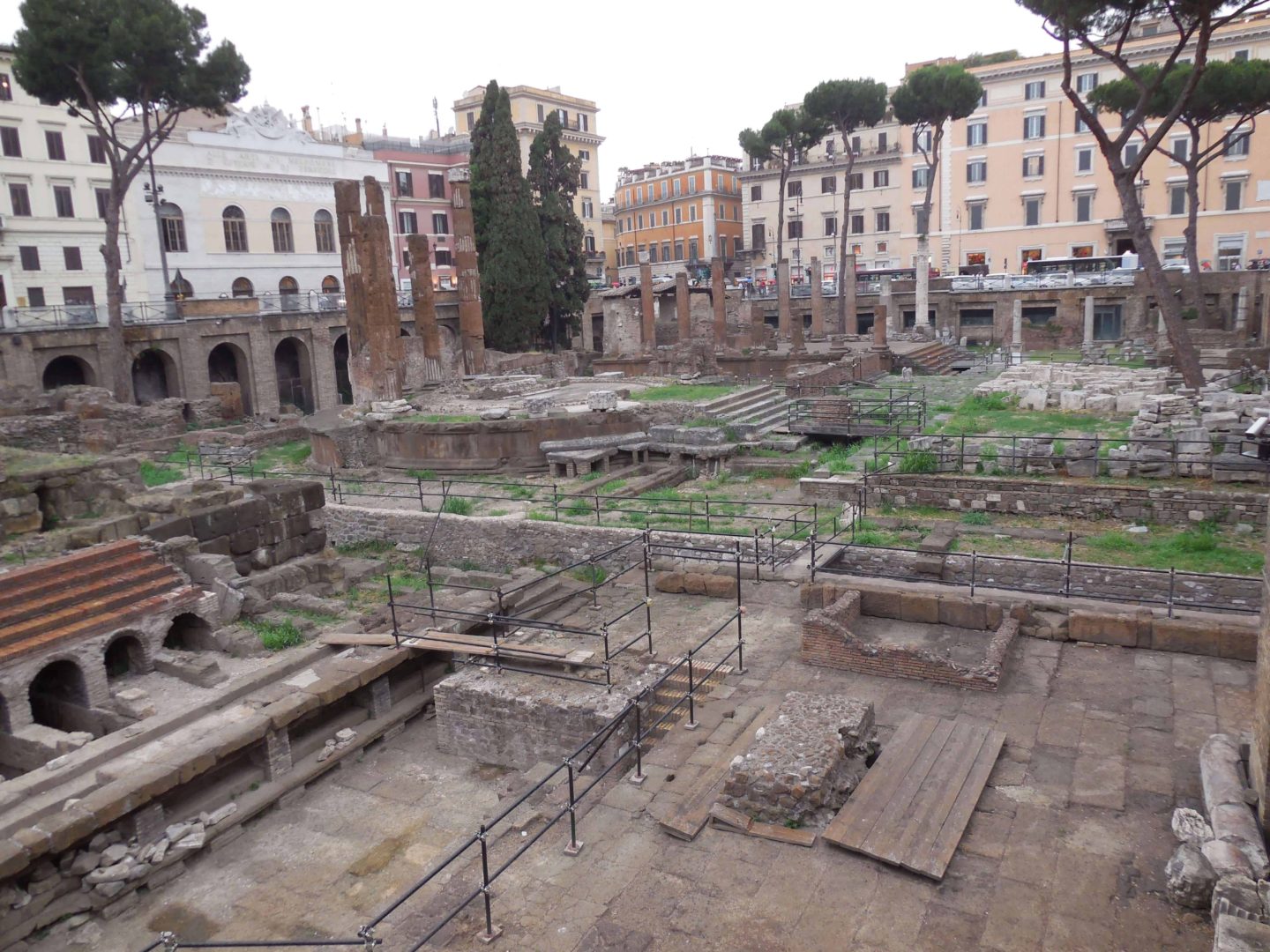
There’s so much to see in Rome and Vatican City (located inside Rome’s city limits) that you can visit the city many times and see something different each time.
Some of Rome’s Highlights
- A comprehensive walking tour of the Vatican. We took an early morning tour of the Vatican and were able to enjoy the Sistine Chapel before the crowds of tourists arrived.
- Walking in the Pantheon (which we did several times as we chose a wonderful hotel just steps away). When you look directly at the front of the Pantheon (without noticing its dome), it looks like the run-of-the-mill Roman site because all the decorative marble has long since been removed, exposing its raw stone structure. It also doesn’t look that large. Then go inside—the floor, the walls, and oh, the ceiling. The dome looks like a well-engineered 20th-century structure, not a 2,000-plus-year-old structure that is the world’s largest unreinforced concrete dome to this day. Then there’s the oculus — a 30-foot hole in the very top of the dome. Some say it was supposed to be a sundial. The reality is that it acts as a perfect ventilation system for a structure with such a dome. When it rains, no worries inside. This incredible building was designed so that there would be upward airflow most of the time. So, when it rains, the upward airflow of the Pantheon prevents the rainwater from entering the dome’s oculus. They may not have known the science and mathematics behind much of their engineering projects, but they surely knew the practical principles.
- The Spanish Steps lead people from the Piazza di Spagna to the Trinità dei Monti church above. Dating to the 18th century, the 135 travertine steps are considered a monument. They were once a popular place to sit, relax, and people watch; now, however, people are no longer able to do so and may be fined if they try.
- Located at the intersection of three streets in central Rome, the Trevi Fountain is a mecca for tourists. Standing over 86 feet high, the Trevi Fountain has been popularized by Hollywood — including the films Roman Holiday (1953) and Three Coins in the Fountain (1954). One of the results of its popularity is how much money it yields on a daily basis, as tourists often toss coins over their left shoulders into the fountain for good luck.
- Visiting the Colosseum which is much larger than we imagined. Again, though long since stripped of its decorative marble, the stone structure clearly demonstrates the design and engineering prowess of the Romans. One can only imagine how it would have looked with the canvas awning that covered the seating area around the entire structure. Given our fascination with the structure itself, it is a sad part of history and chapter in the development of society that such an incredible testament to human ingenuity was put primarily to such depraved use.
- Taking tours of the Roman Forum and the Capitoline Museums (three museums connected by underground galleries). In the Roman Forum stand the remains of the buildings that were once the center of the Roman government. In the Capitoline Museum, you’ll see works depicting Roman history including the ancient statue of Marcus Aurelius (Roman emperor from 161 to 180) on horseback, the statue of a she-wolf nursing Romulus and Remus (mythic founders of Rome), and the sculpture of the Boy With Thorn.
- Enjoying a leisurely meal at just about any cafe, sipping wine, and watching the world go by. We especially enjoyed eating in the Campo di Fiori with its lively action and market.
- Being serenaded by street musicians in a variety of piazzas.
- Walking around Hadrian’s Villa, which is about 15 miles to the east of Rome. The villa was constructed at Tibur (modern-day Tivoli) as a retreat from Rome for Emperor Hadrian during the second and third decades of the 2nd century AD. He came here to escape the heat and politics of Rome. Hadrian is said to have disliked the palace on Palatine Hill in Rome, leading to the construction of this retreat. You’ll see foundations and some walls around the property. Also, you’ll probably be able to imagine Hadrian on his daily walks under the porticos that he had built along the perimeter of large pools to protect him from the harsh sun.
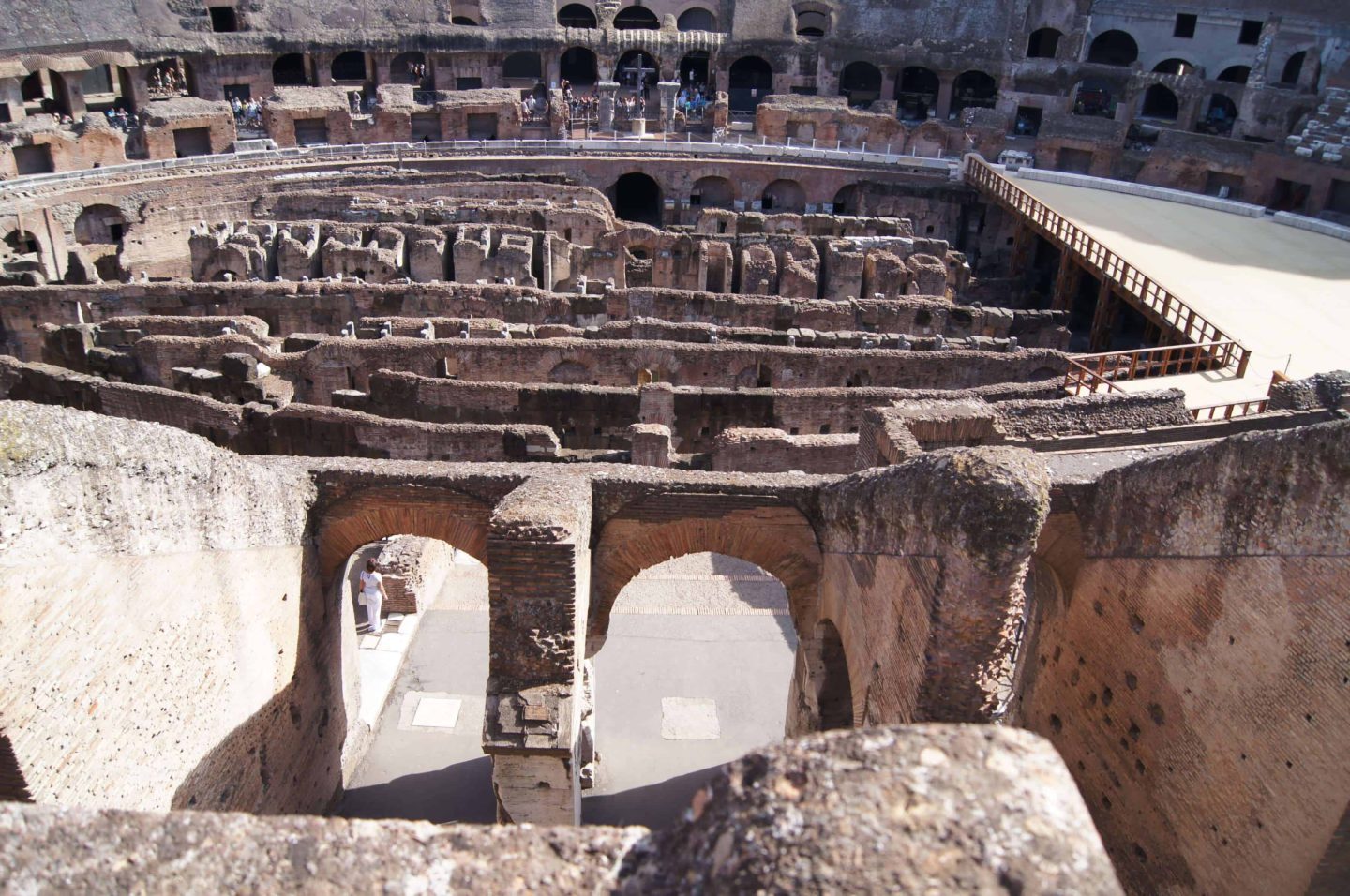
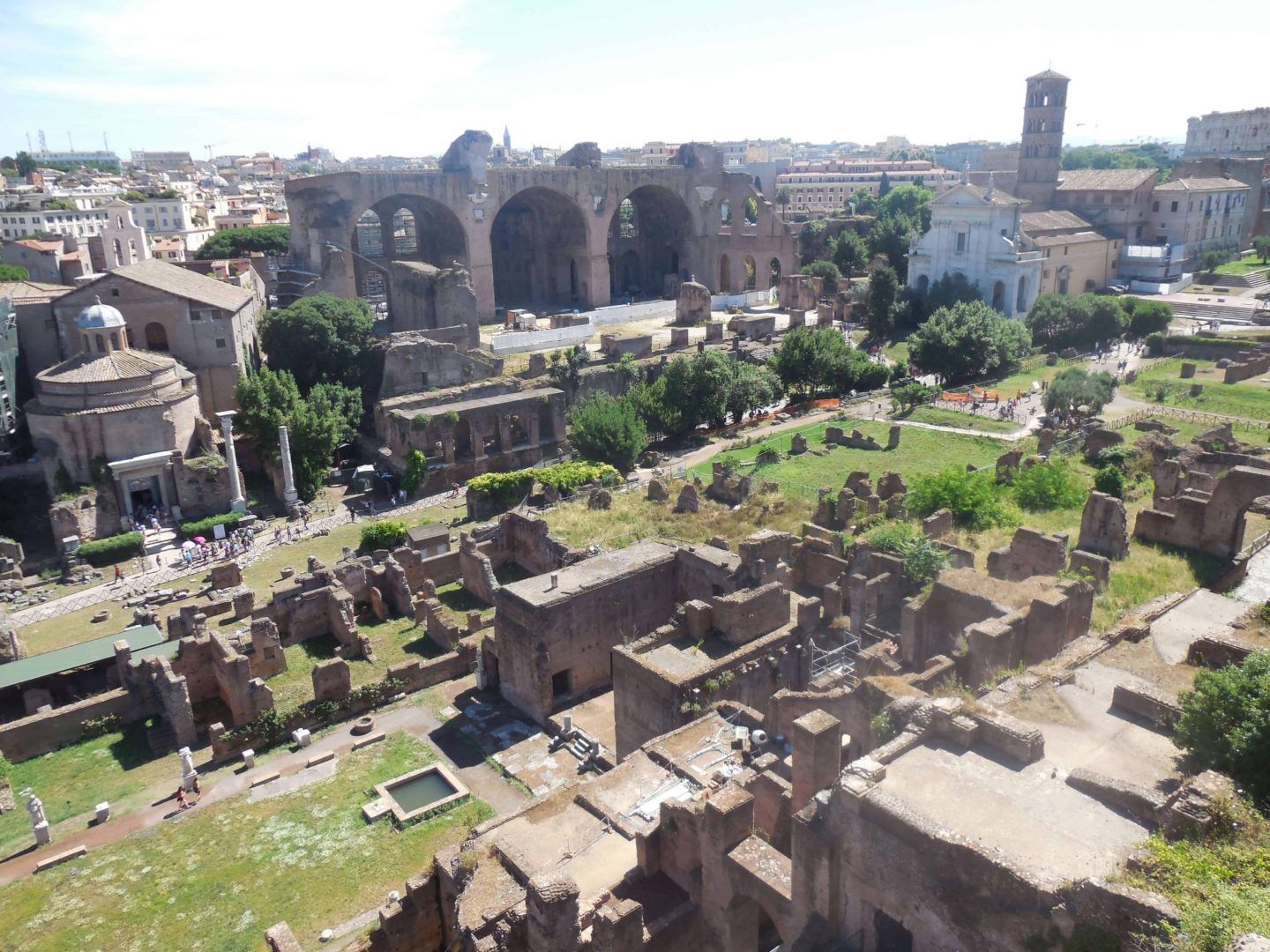
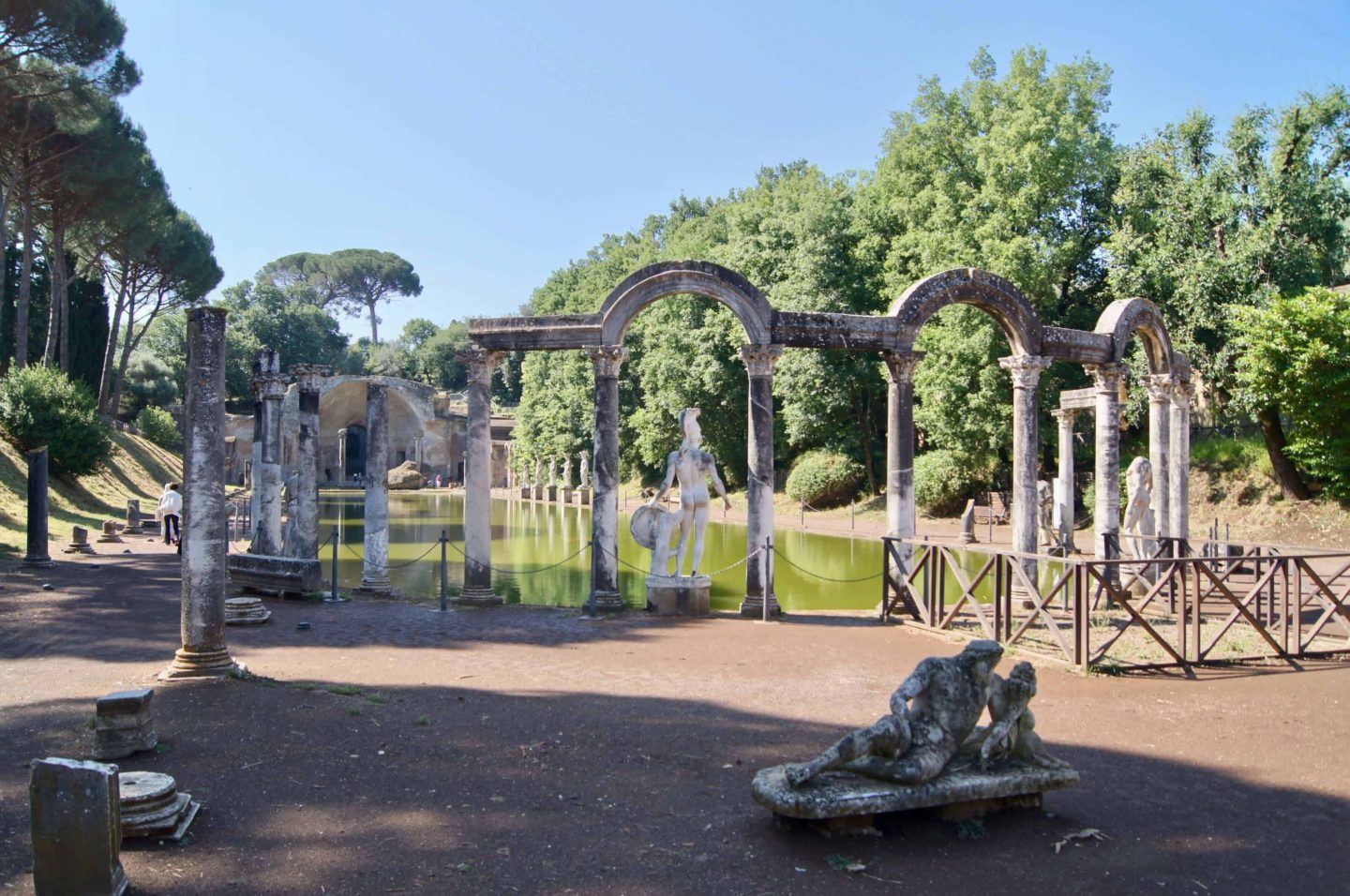
Southern Italy: Naples
Naples comes across to many as the quintessential Italian city: fast-paced with congested traffic. Neighborhoods built along narrow city streets — with laundry hanging from clotheslines that span the street 3-6 flights up — are common sights. In short, Naples has no pretenses. This is what helps to make it so special.
Naples Highlights
- Those old-fashioned neighborhoods have every conceivable hole-in-the-wall Mama and Papa restaurant with fantastic food, excellent carafe wine (no names), as well as attentive service and down-home hospitality — all at modest prices.
- Naples National Archeological Museum. Not only does it have centuries of southern Italian art, but it has the best collection of mosaics and other artifacts rescued from Pompeii itself.
- Enjoying pizza. Naples is the home of pizza. Nothing more needs to be said.
- Riding a funicular up to the Vomero district to visit the Castel Sant’Elmo. The castle is a 14th-century hilltop fortress & former prison with endless panoramic views from its terraces. You’ll see Naples, the Bay of Naples, Mount Vesuvius, and more.
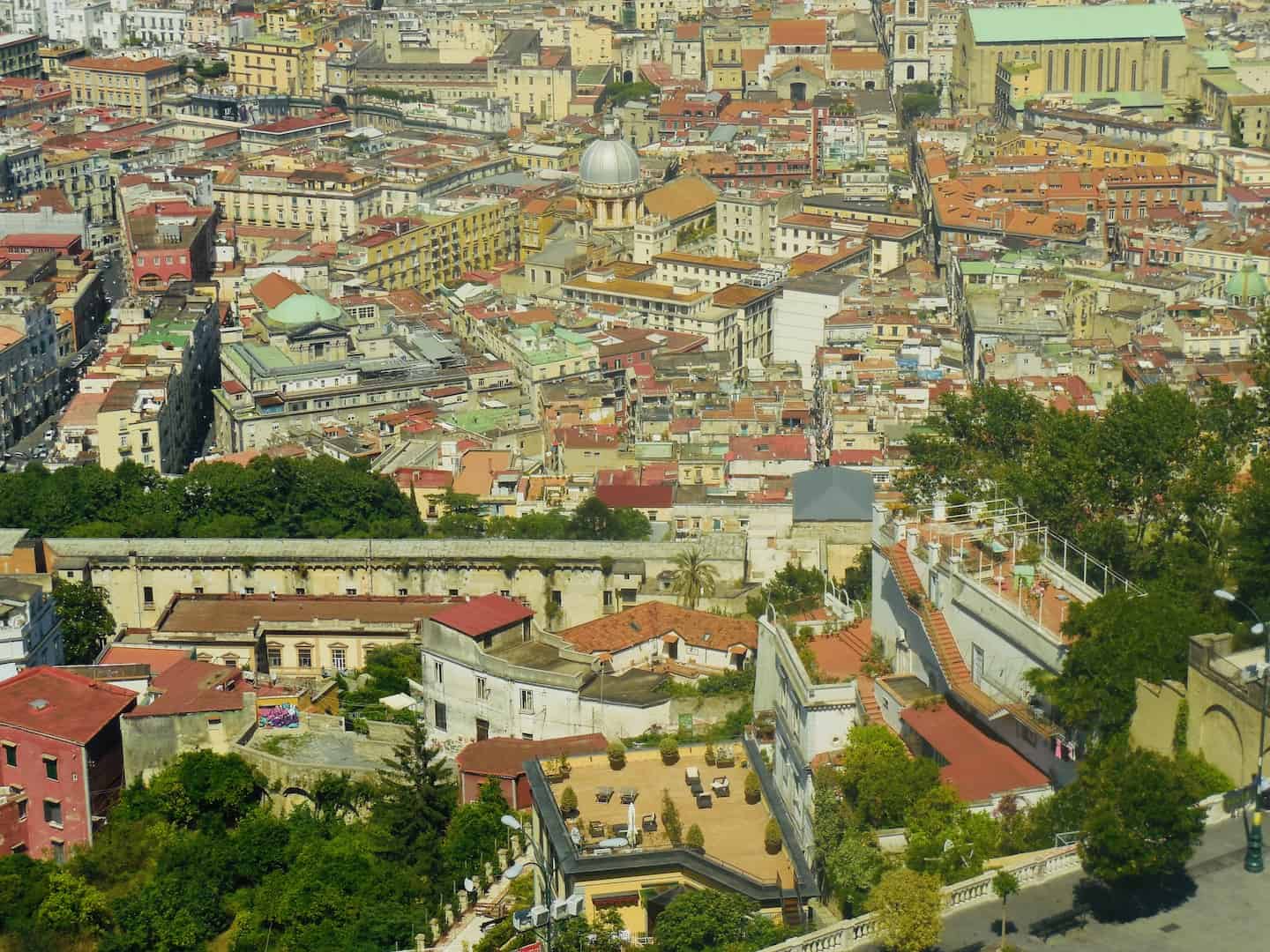
Southern Italy: Sorrento
Sorrento is a very relaxing big town and is easy to traverse on foot. There’s lots of great shopping and it’s a convenient departure point for a boat to the island of Capri.
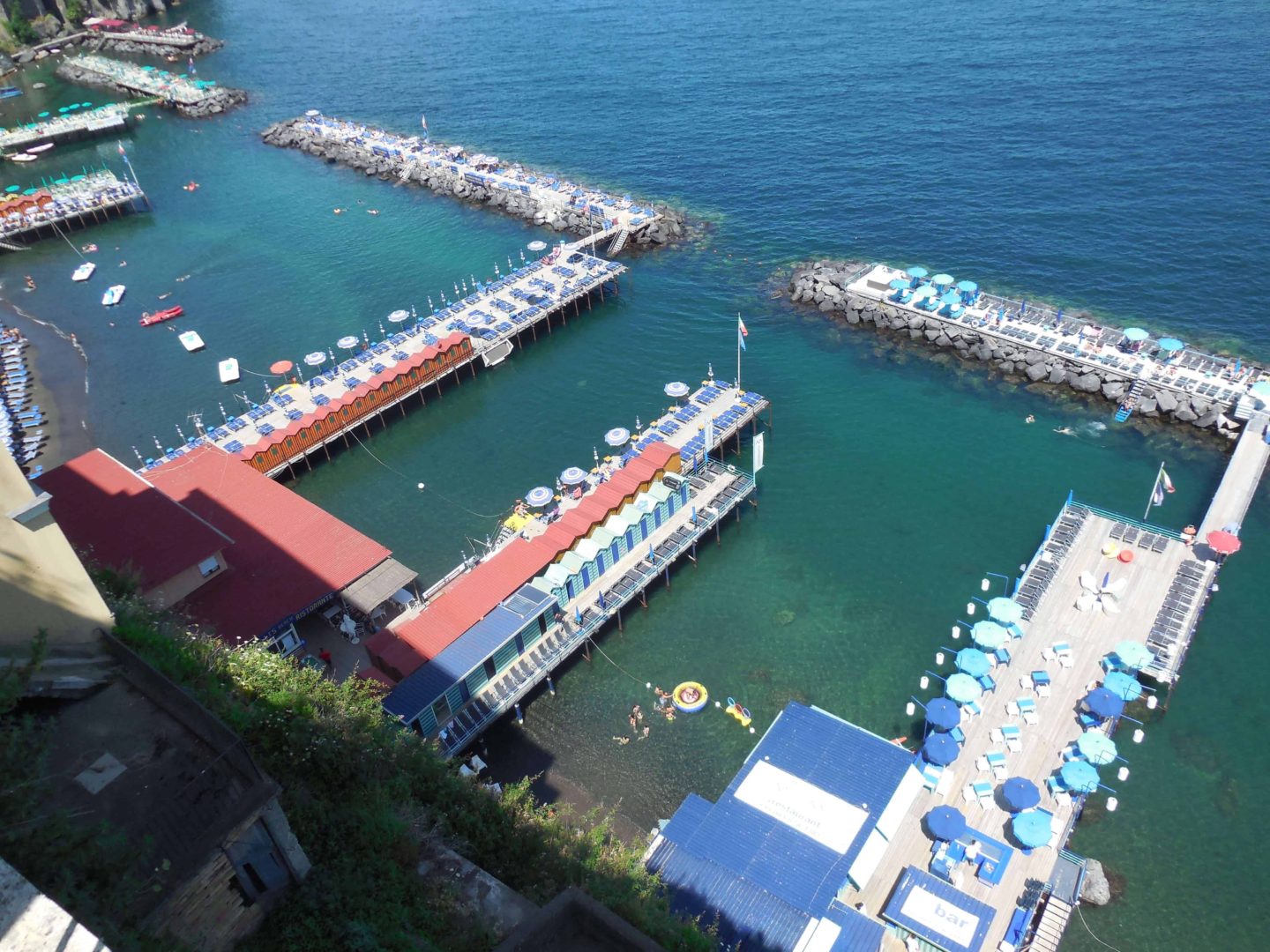
Sorrento Highlights
- Learning more about the commercial home of the region’s lemon commerce and the largest lemons you will ever see. Seriously. Here is also, therefore, the home of limoncello. Saluti!
- Strolling the old-world shopping district which was very enjoyable.
- Enjoying the views from Park Vallone de Mulini overlooking the harbor and beyond.
- Having dinner in the Marina Grande district along the waterfront.
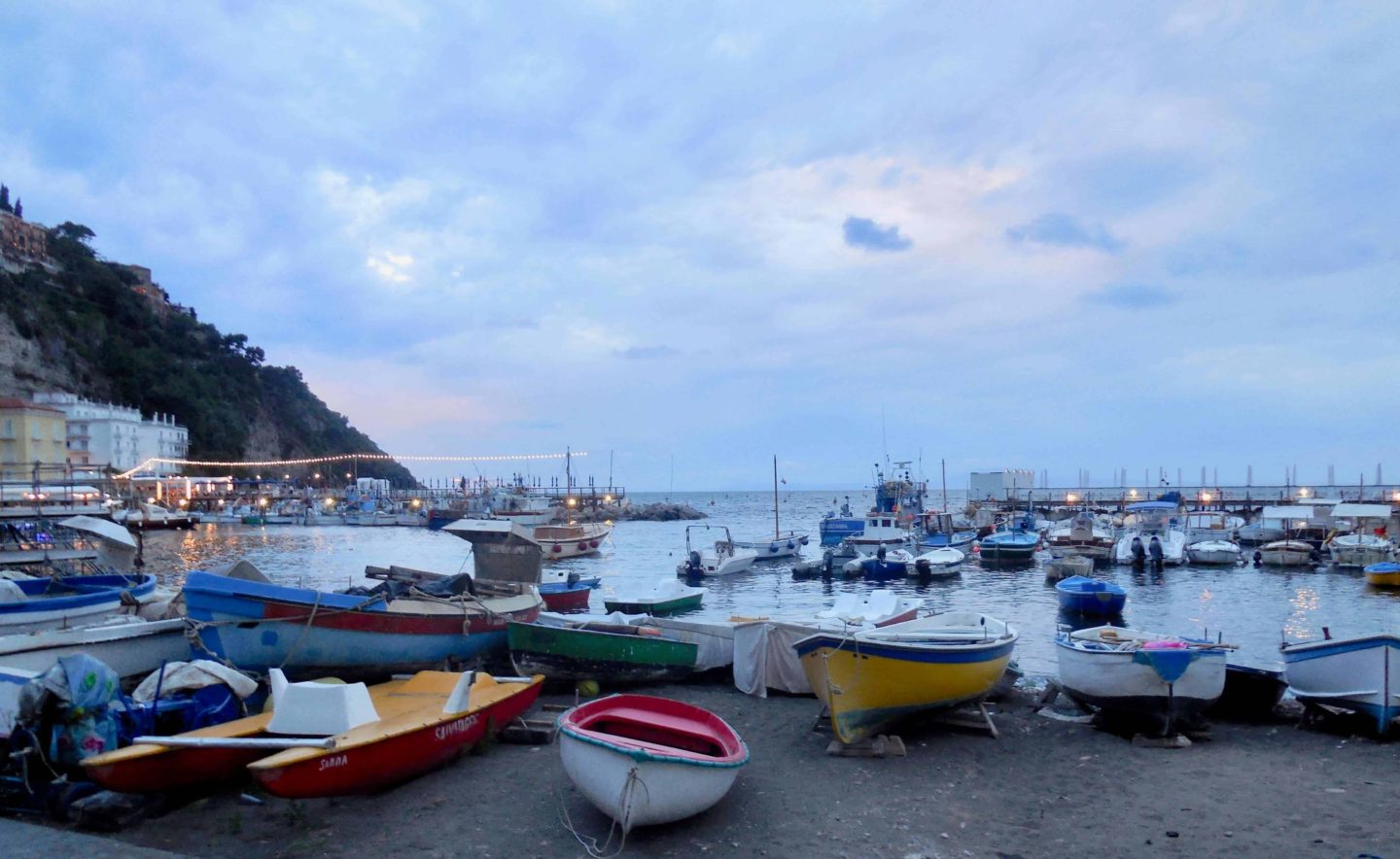
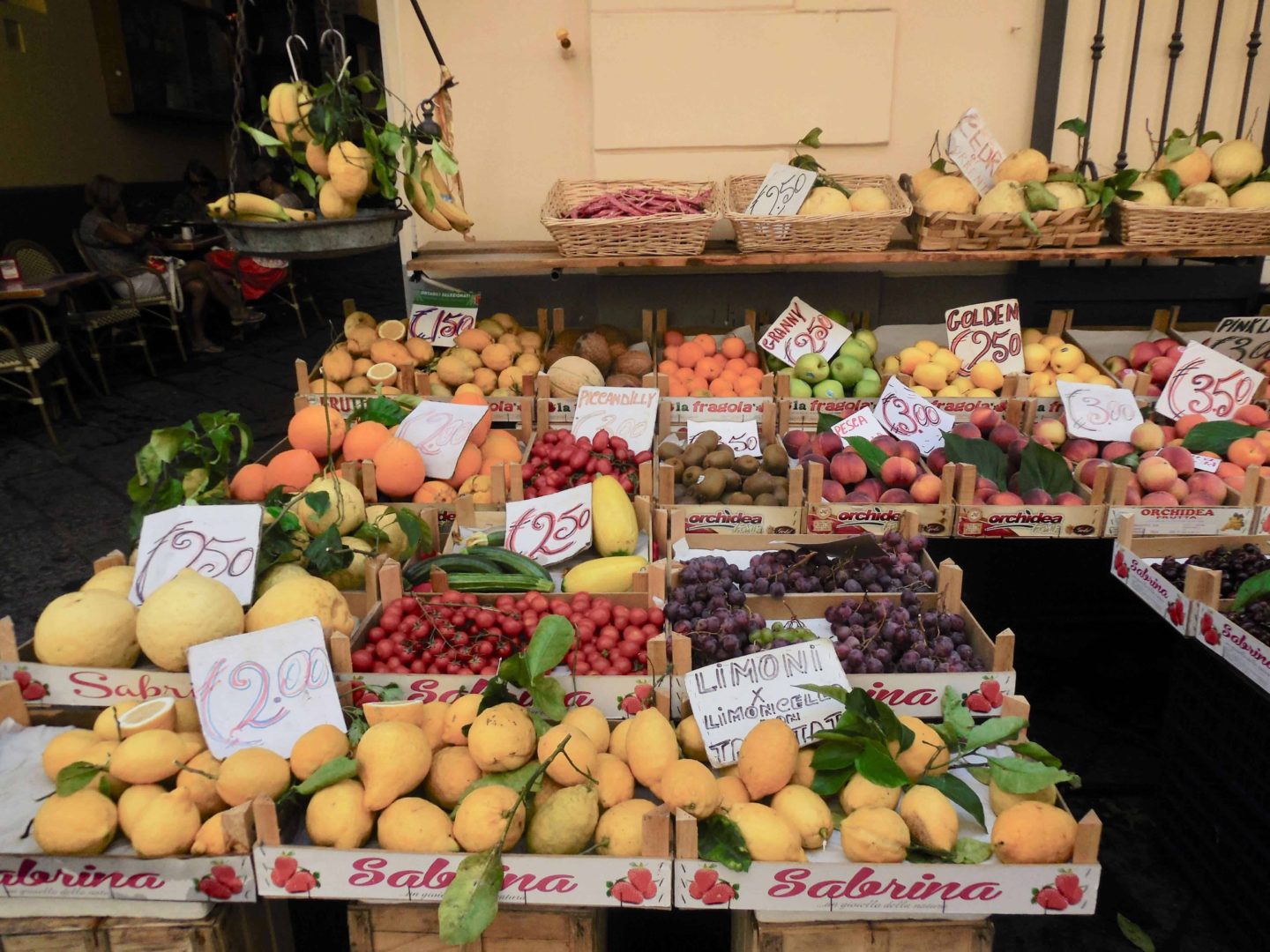
Southern Italy: Pompeii
We were staying in Sorrento, so getting to Pompeii was simply a matter of getting on a regional commuter train and getting off at the correct stop. The sections of Pompei that have been uncovered are remarkably well-preserved. This, combined with a guide that told us a great deal about life in Pompeii before the eruption, turned this “check-the-box” visit into something very special. We recommend taking a guided tour, so you get the most out of your visit.
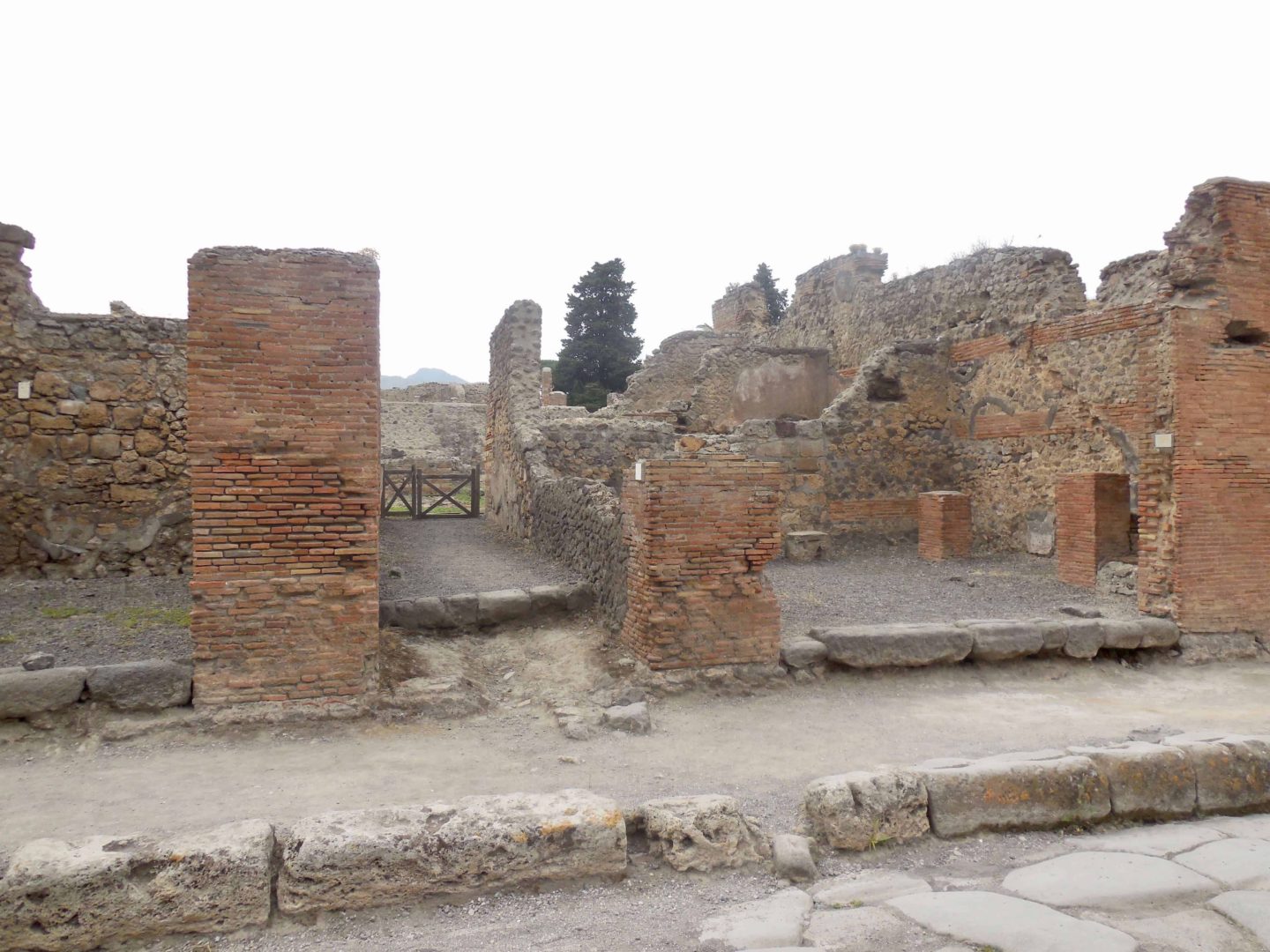
Pompeii Highlights
Our whole visit to Pompeii was a highlight! Here are some of the takeaways from this impressive place:
- The city’s layout was well planned, including the main square, arena, business sectors, and bathhouses. The streets were laid out in a grid system, and the main streets ran east to west to maximize sunlight during the day.
- The spas (separate ones for men and women) with steam rooms, pools, and massage areas meant the citizens practiced good hygiene, cutting down on diseases.
- Small marble chunks were embedded in streets to serve as reflectors at night.
- A masterfully designed street-sidewalk system.
- First, the streets were offset deep compared to sidewalks and adjacent buildings to keep the muck and mire of wagons, horses, and humans clearly separated from pedestrians.
- Second, fountains in all those squares were designed to overflow. Since the streets were correspondingly designed to gently slope towards the Bay of Naples, as the fountains overflowed, the water would run down the streets towards the bay, carrying with it the muck and mire of the streets (i.e., a highly engineered passive, continuously operating street cleaning system).
- Third, they invented “street crossings” using stepping stones that ensured pedestrians could easily get to the other side.
- Fourth, Pompeii created a standard for the gauge of wagons allowed into the city (i.e., a standard side-to-side width for the wheels of a wagon). Those stepping stones were spaced so that those standard gauge wagons could easily pass through those elevated crosswalks without a problem. Amazing.
- Merchants had their offices in the front of their living areas behind doors. These homes had all the standard rooms and even indoor running water (piped in by lead pipes that, over time, developed a strong lining of mineral deposits that ultimately protected residents from lead poisoning). This internal plumbing system was part of a city-wide water system that, via aqueducts, brought water from the surrounding mountains to feed homes, businesses, and fountains in the numerous squares throughout the city.
- Homes had large dining rooms (many with frescoes) because citizens laid down while eating, so there needed to be room for large stone sofas.
From Sorrento to the Amalfi Coast
Warning: Driving from Sorrento to the Amalfi Coast is best left up to locals. We did not drive this ourselves — we are adventurous but not crazy. Instead, we took a bus. Leaving the Sorrento area, the highway was packed with all sorts of motorized vehicles. A multi-mile tunnel is part of the highway journey before it turns into a two-lane road. Under normal conditions, this would have no interest; however, this was exciting to watch with all forms of motorized vehicles combined with the occasional adherence to traffic lane separation. (Our bus driver had the look of “just another day.”)
The two-lane portion became increasingly narrow and winding. At points, traffic would stop so that one tour bus could make a sharp bend in the road. There were precipitous drops down to the water on the west side of the road. This is all done while motorcycles and scooters are fearlessly weaving in and out. The most amazing two-wheeler sight was a scooter doing its traffic slalom with Dad driving, Mom anchoring the back of the seat, two kids sitting in between them, and the family dog napping on that little running board of the scooter under Dad’s feet. We frequently rent a car and take full responsibility for implementing our itinerary. The Amalfi Coast was another story.
Southern Italy: Amalfi Coast
The Amalfi Coast is a 30-mile stretch of coastline along the southern edge of Italy’s Sorrentine Peninsula in the Campania region. It’s a popular holiday destination, with sheer cliffs and a rugged shoreline dotted with small beaches and pastel-colored fishing villages. The coastal road between Sorrento and the port city of Salerno winds past grand villas, terraced vineyards, and cliffside lemon groves.
Southern Italy: Positano, Amalfi Coast
Positano was our base from which to explore the Amalfi Coast. The town itself is very touristy but also very enjoyable. Be prepared to climb a lot of steps and high-grade pedestrian walks. All the Amalfi towns are perched on the sides of large steep hills rapidly descending into the sea. Some even have a small beach. Also, many/most of the streets in these towns have been converted to pedestrian walkways to take advantage of tourism.
Positano Highlights
- Enjoying the view from our hotel room. During the day, the colors of the buildings, coupled with the vision of them rising from a beautiful sea, are difficult to describe effectively. Sunset brought its own magnificent version followed by the evening.
- Meandering up, down, and throughout the town taking in all the shops, cafes, and mini-vistas.
- Visiting the beach, enjoying the busy comings and goings of people (including a couple of elderly men in Speedos!), and looking back up at Positano.
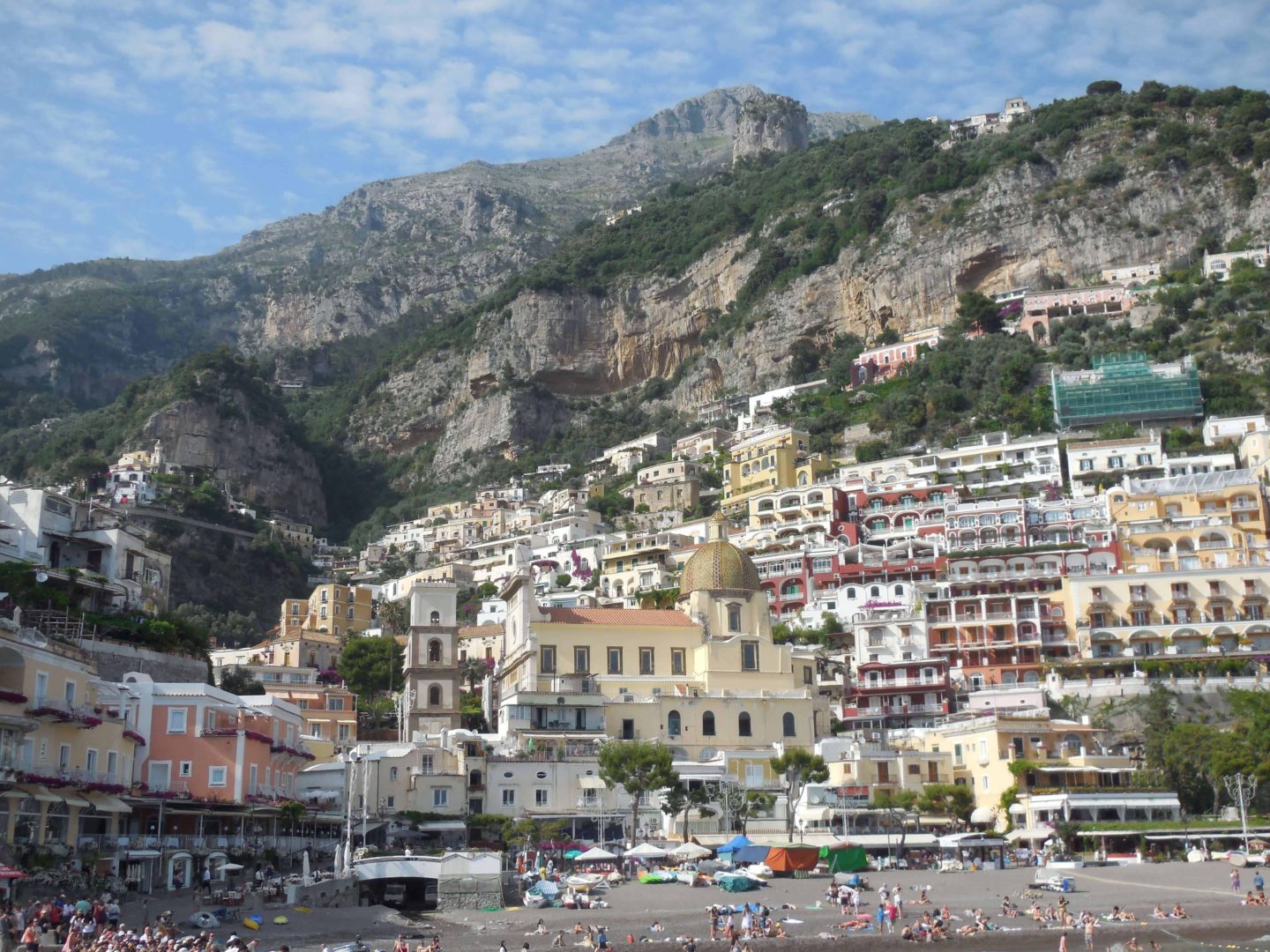
Southern Italy: Amalfi, Amalfi Coast
From Positano, we took a ferry to Amalfi. Amalfi is a town in a dramatic natural setting below steep cliffs on Italy’s southwest coast. Between the 9th and 11th centuries, Amalfi was the seat of a powerful maritime republic. The Sant’Andrea cathedral at the heart of town, with its striped Byzantine facade, survives from that time period. Similar to Positano, the views from Amalfi are wonderful, and strolling through the town is key to experiencing Amalfi.
Southern Italy: Ravello, Amalfi Coast
Geographically, Amalfi is located along the water, and Ravello is a small hilltop town above Amalfi. We opted to spend time here because we knew it would be less touristed than other spots along the Amalfi coast. Plus, we felt it would be a welcome diversion. We took a bus from Amalfi to reach Ravello. Finally, someplace that is relatively flat!
The views from Ravello of Amalfi below, the sea, and up and down the coast are spectacular. This is a great place for a leisurely day.
Ravello Highlights
- Exploring the shops along the large town square.
- Lunch at the Villa Cimbrone. Wonderful views and a delicious lunch.
- Strolling the beautiful gardens of the Villa Cimbrone after lunch.
- Shopping for hand-painted pottery, a treasured souvenir of our visit.
- Negotiating with a cabbie for a ride back to Amalfi, thus avoiding the hassle of a commuter-time bus ride back down. We actually ended up sharing a cab with an Australian attorney (who did most of the negotiating) and his wife. Traveling really does open up many interesting opportunities!
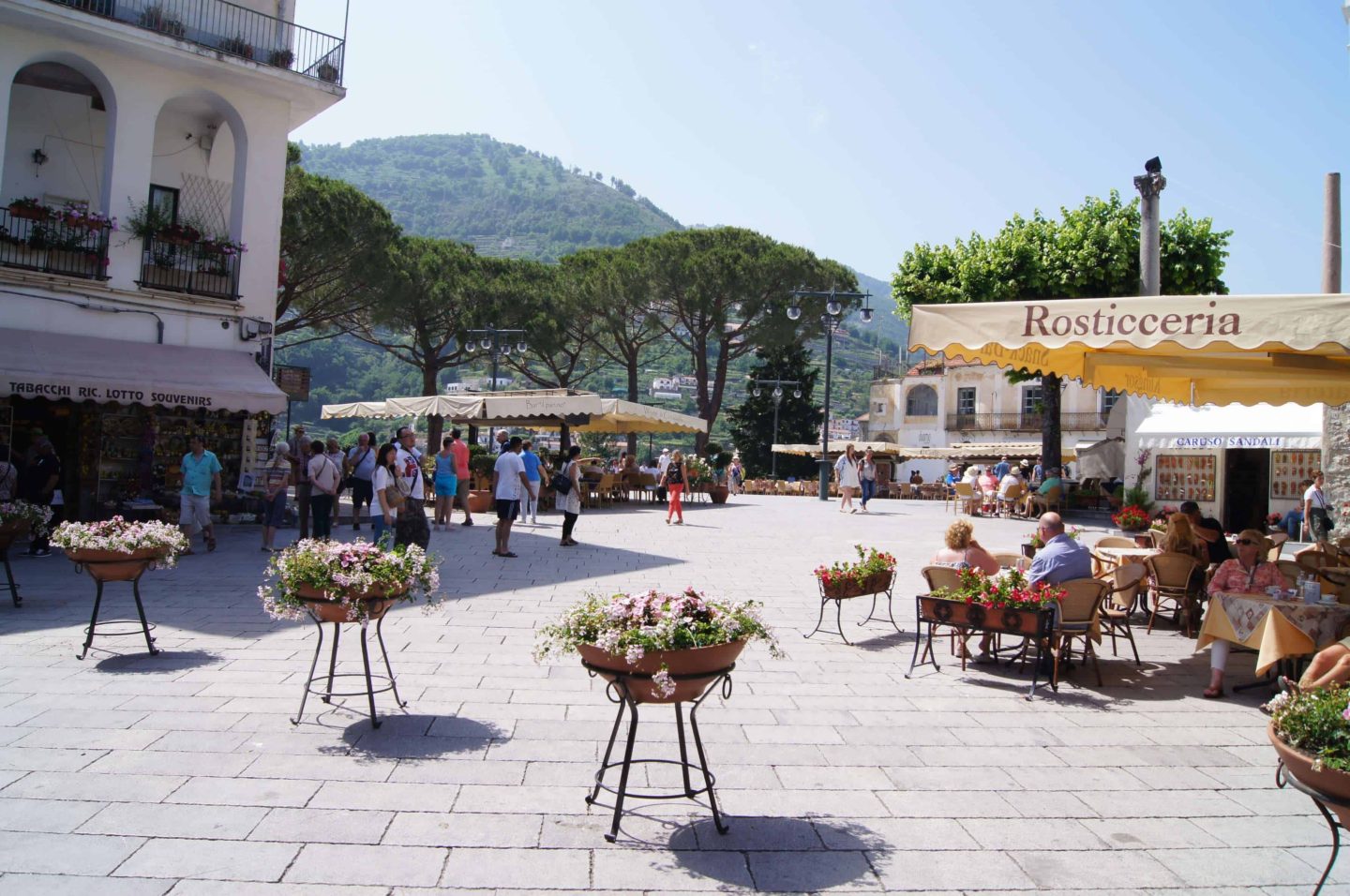
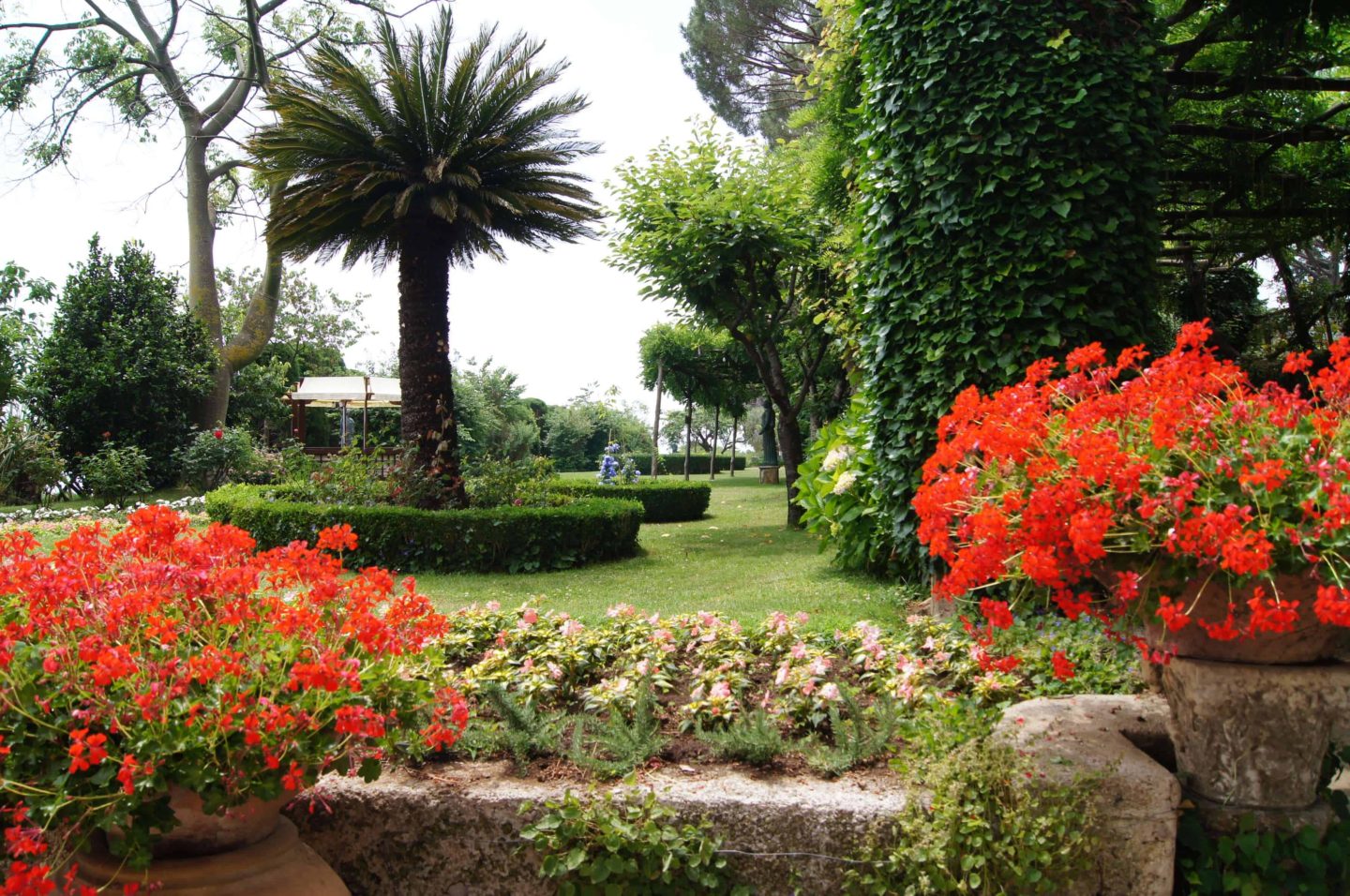
Southern Italy: Paestum
Paestum is an ancient Greco-Roman town in the Campania region in southern Italy. Settled by the Greeks in the 6th century BC, Paestum was later occupied by the Romans and others. It was ultimately abandoned in the 9th century AD due to its mosquito-infested swamps. As a result, its original Greek ruins have been incredibly preserved. Some say that the Greek temples in Paestum are second only to those of the Acropolis in Athens.
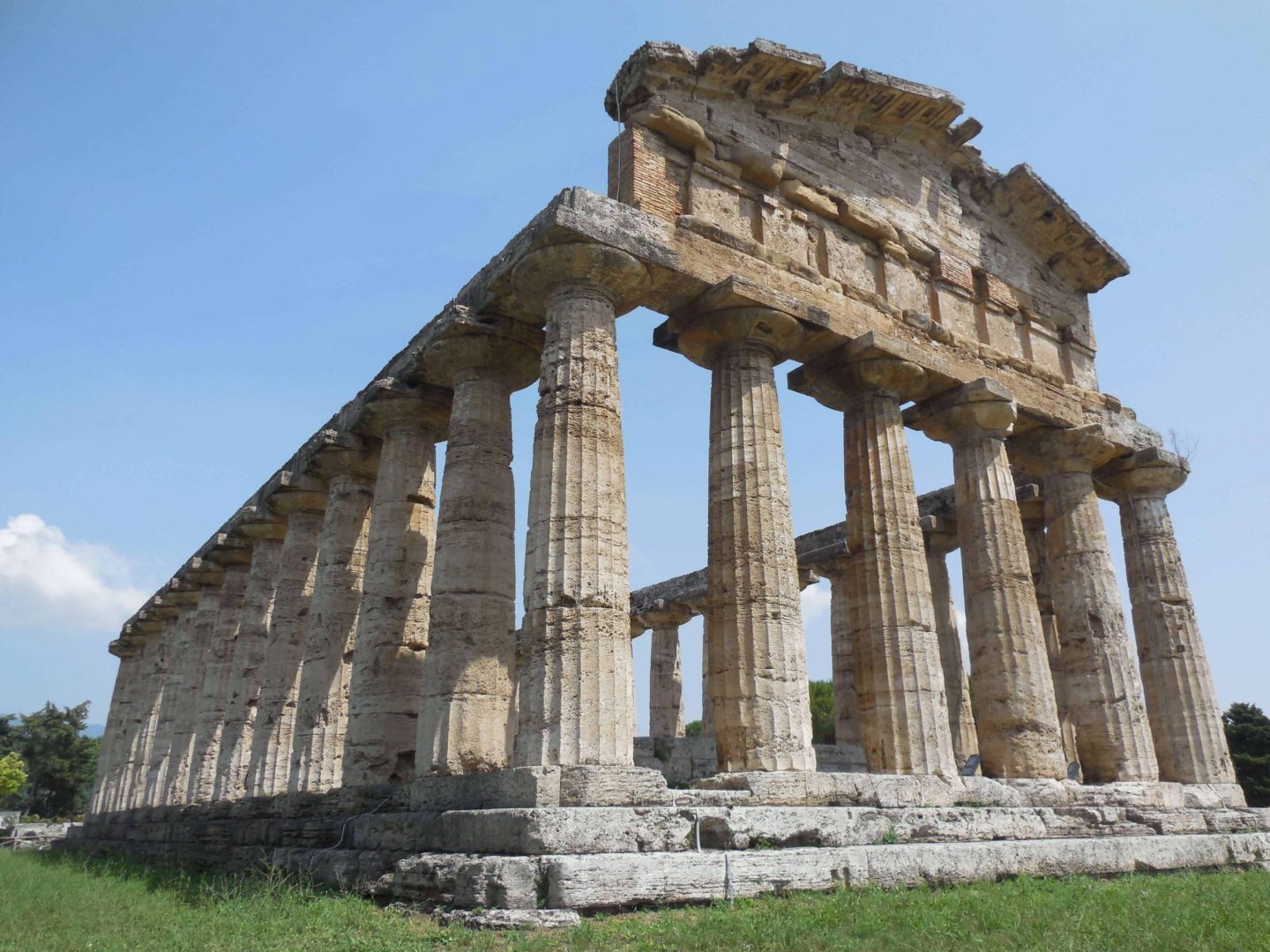
Paestum Highlights
- Walking around the three large temples (dedicated to Hera, Athena, and Poseidon) in the Archaic version of the Greek Doric order, dating from about 550 to 450 BC. All are typical of the period with massive colonnades.
- Strolling through the balance of the archaeological site exploring the remains of homes, baths, and other common areas.
- Visiting the museum at Paestum. It puts into strong perspective the archeological site while providing wonderful exhibits of frescos and portions of ancient rooms.
- Visiting Tenuta Vannulo, an organic water buffalo farm located a short distance from Paestum, is a worthwhile trip add-on and a real treat. When we visited, there were hundreds of female buffalo and just 8 males. The buffalo are serenaded with classical music each morning for two hours. They can wander over to the massaging drum brushes anytime they want. These practices are believed to help keep the buffalo happy and producing the best milk. In an effort to make the milking process less stressful for the buffalo and more efficient for the humans, buffalo enter the robotic milking machine when they want twice a day, and the machine extracts the milk from the animal. The device calculates output, fat content, and other metrics. Calves are milked by their mothers for the first several hours after birth, and the rest of the mother’s milk is used to make the delicious mozzarella, yogurt, and ice cream they sell.
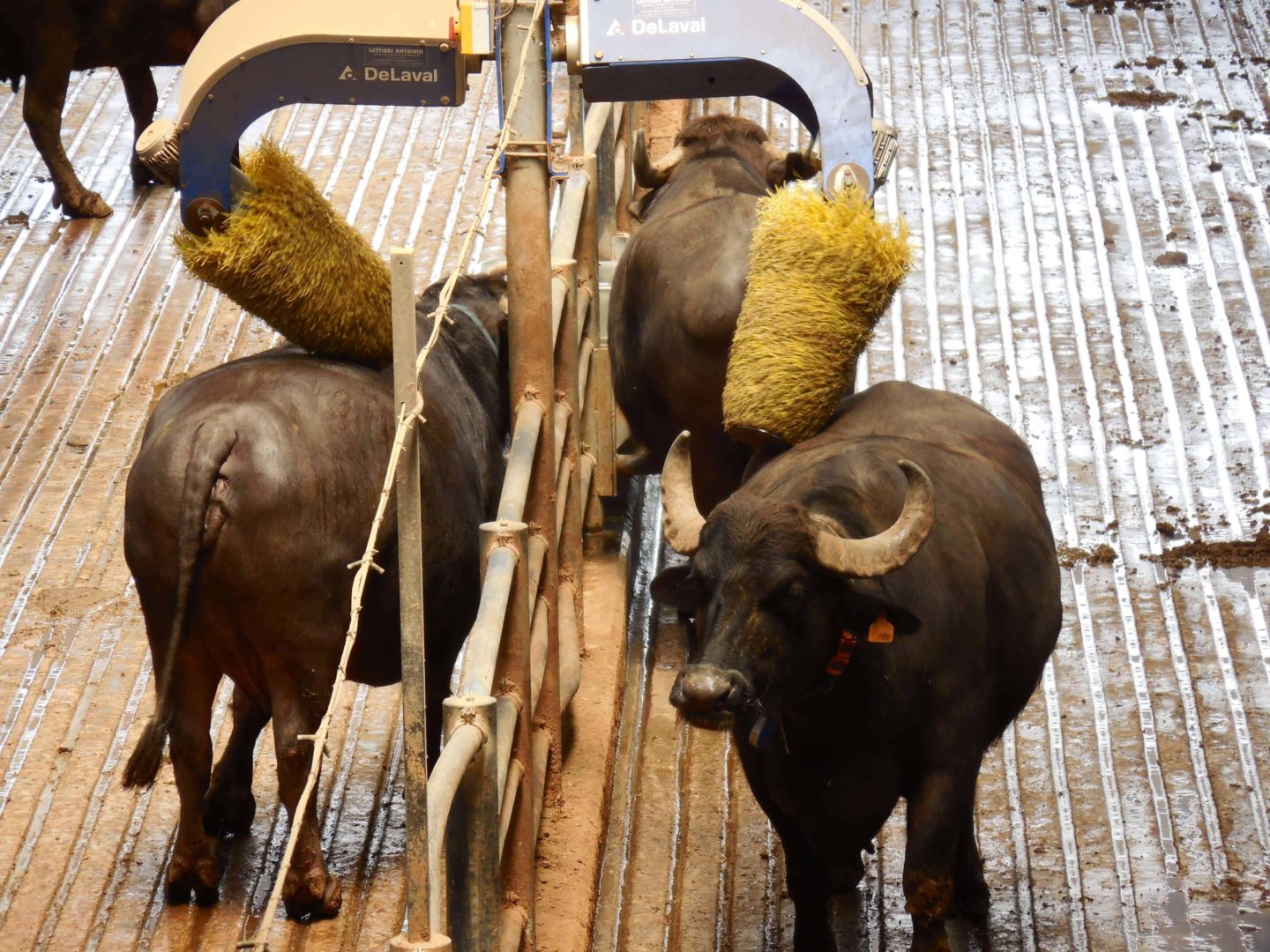
Southern Italy: Matera
Founded in the 3rd century BC, Matera is a city on a rocky outcrop in the region of Basilicata, in southern Italy. This is one of the oldest cities in the world that survives to this day. It includes the Sassi area, a complex of cave dwellings carved into the mountainside. As the town developed, the “back-end” of a home would be carved out of the rocky hillside. A more traditional masonry “front-end” of the home was then added. This was the configuration of our hotel room; we had never experienced anything like it. In fact, we have never experienced anything like Matera in our world travels. If you plan to visit Southern Italy, do your best to spend a full day and an overnight in Matera.
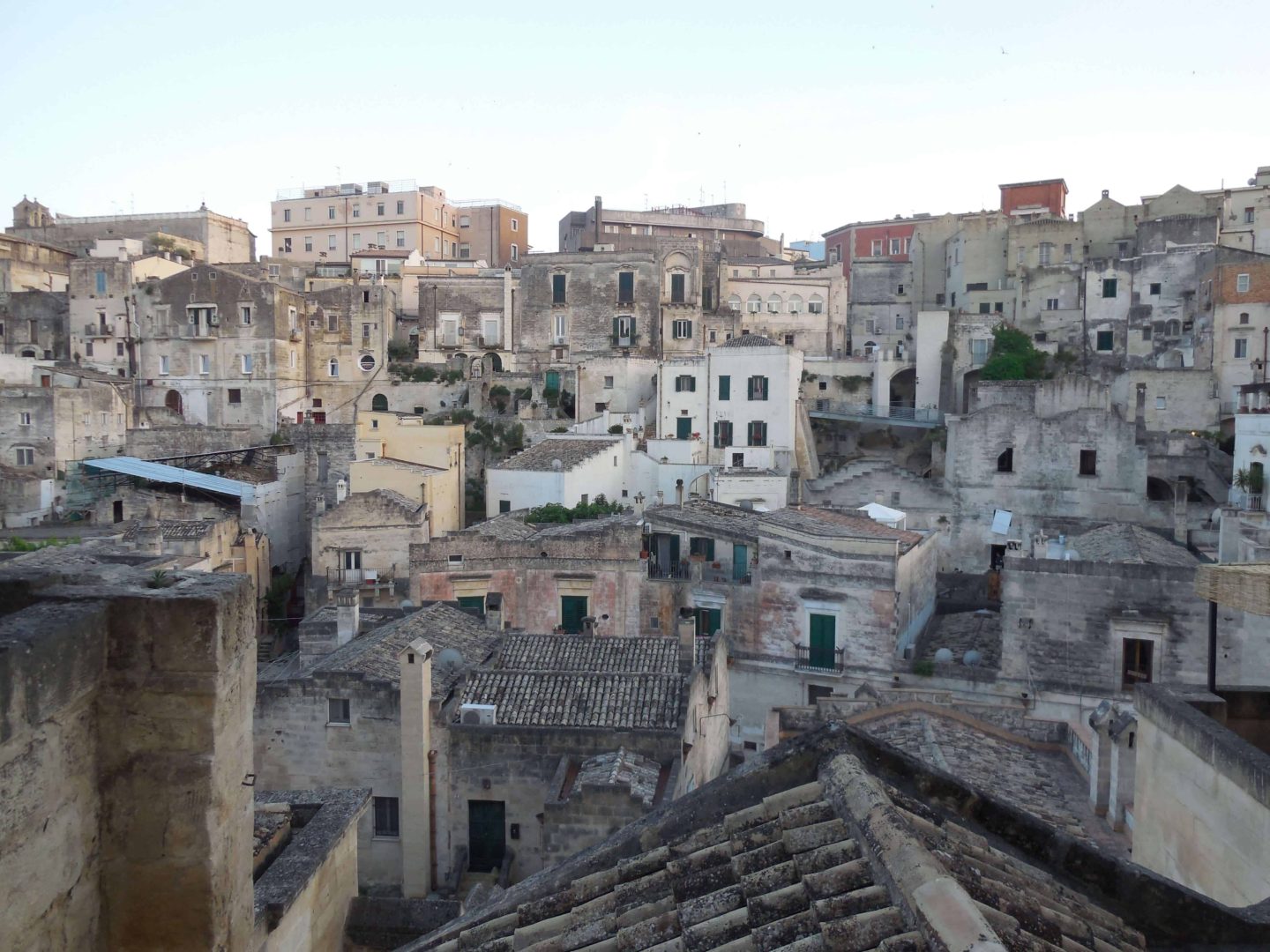
Matera Highlights
- The pure explosion of visual interest of a town built right into the rocky sides of a hill/ravine that rapidly descends to a small stream and then rapidly ascends on the other side. Views during the day and evening are equally amazing.
- The Matera Cathedral built in the 13th century with a skyline-dominating bell tower and ornate interior decorations.
- Casa Grotta nei Sassi, a historical site featuring a recreated cave dwelling with period furnishings, tools & artifacts.
- Strolling the promenade on a Saturday evening and getting a feel for the town and its people. Older people were dressed more formally (men in suits) for their weekly social outing while younger people were much more casually dressed (as they would be in America) and darted in and out of pizza and ice cream shops.
Southern Italy: Vieste
A longtime fishing village on the Adriatic Sea (southeast coast of Italy), Vieste is now a popular tourist destination in northern Puglia, on a spur that juts into the sea. Actually, Vieste is about 260 miles due east of Rome.
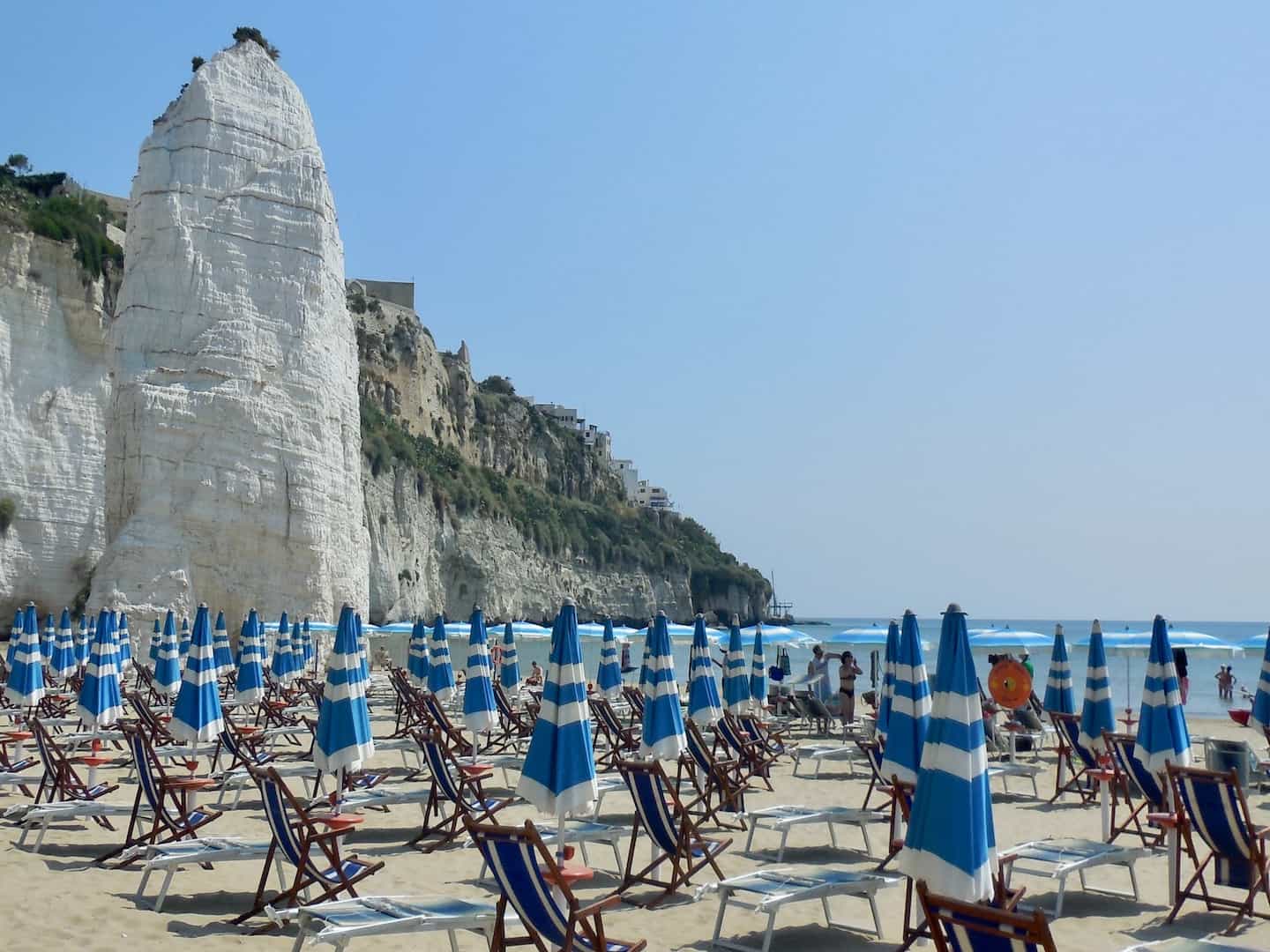
Vieste Highlights
- Taking an incredible boat ride to about half a dozen caves/grottos. The water views were wonderful, but the experience of going into the grottos was breathtaking. On our excursion, the captain slowed the boat considerably as it approached a grotto and then inched its way inside. After a while, the captain adeptly reversed the boat back outside when we were done begin completely awed by the natural beauty surrounding us. You can catch the boat tours at the marina in town.
- Wading into the Adriatic Sea with its clear, refreshing, warm water. We walked down to the beach with its endless rows of beach lounges awaiting the tourists who would soon be arriving en masse. (We visited in June which was just before the peak tourist season begins in southern Italy.)
- Stopping at the open air market (on our way back from the beach) to buy some vacuum wrapped cheese and dried garlic to take with us. As our luck would have it, we forgot it in the hotel room when we left! I’m sure the lucky crew who cleaned our room after we left enjoyed it, though.
- Sipping some refreshing limoncello at an outdoor cafe on a summer evening and enjoyed the company of other travelers.
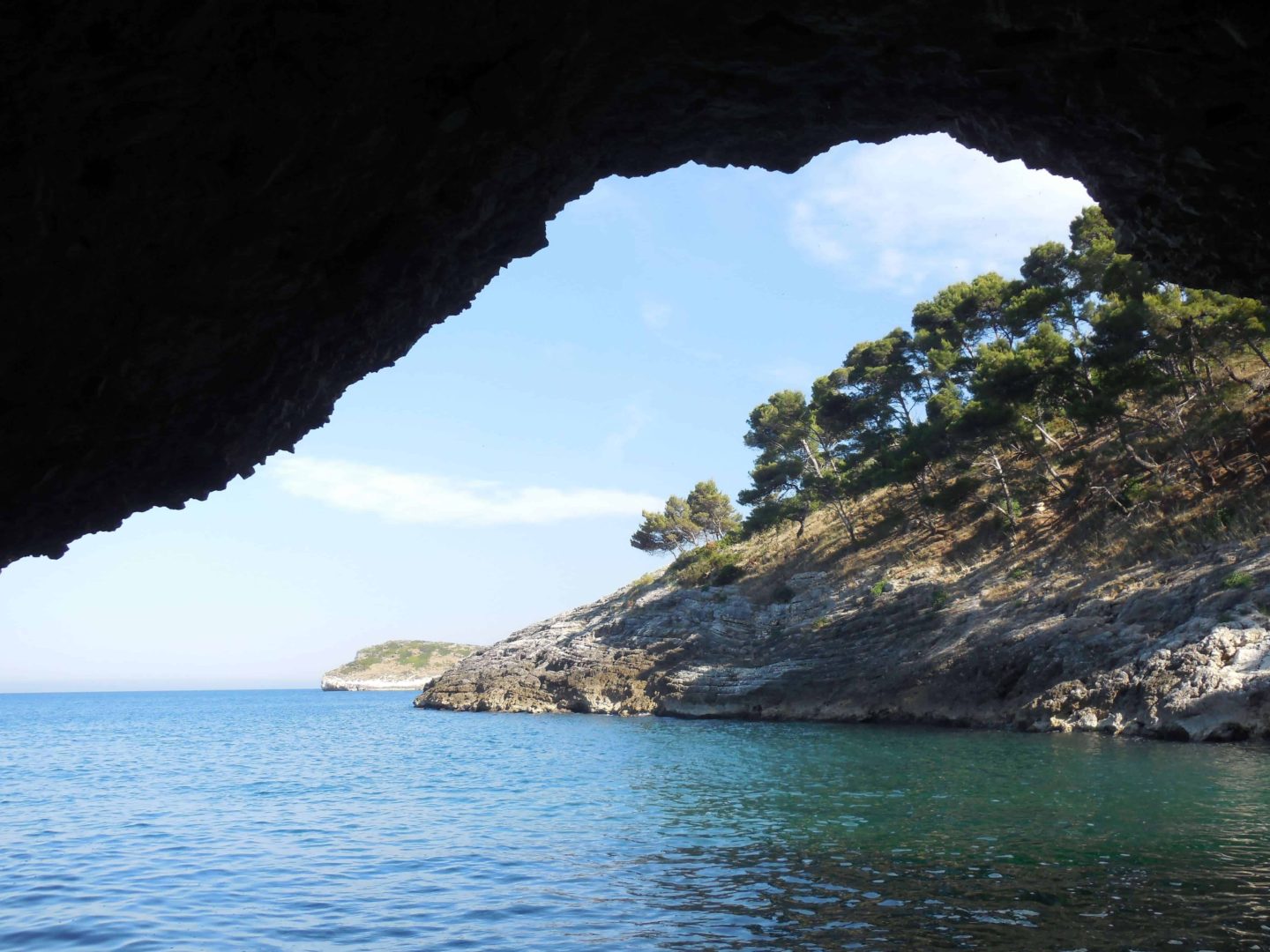
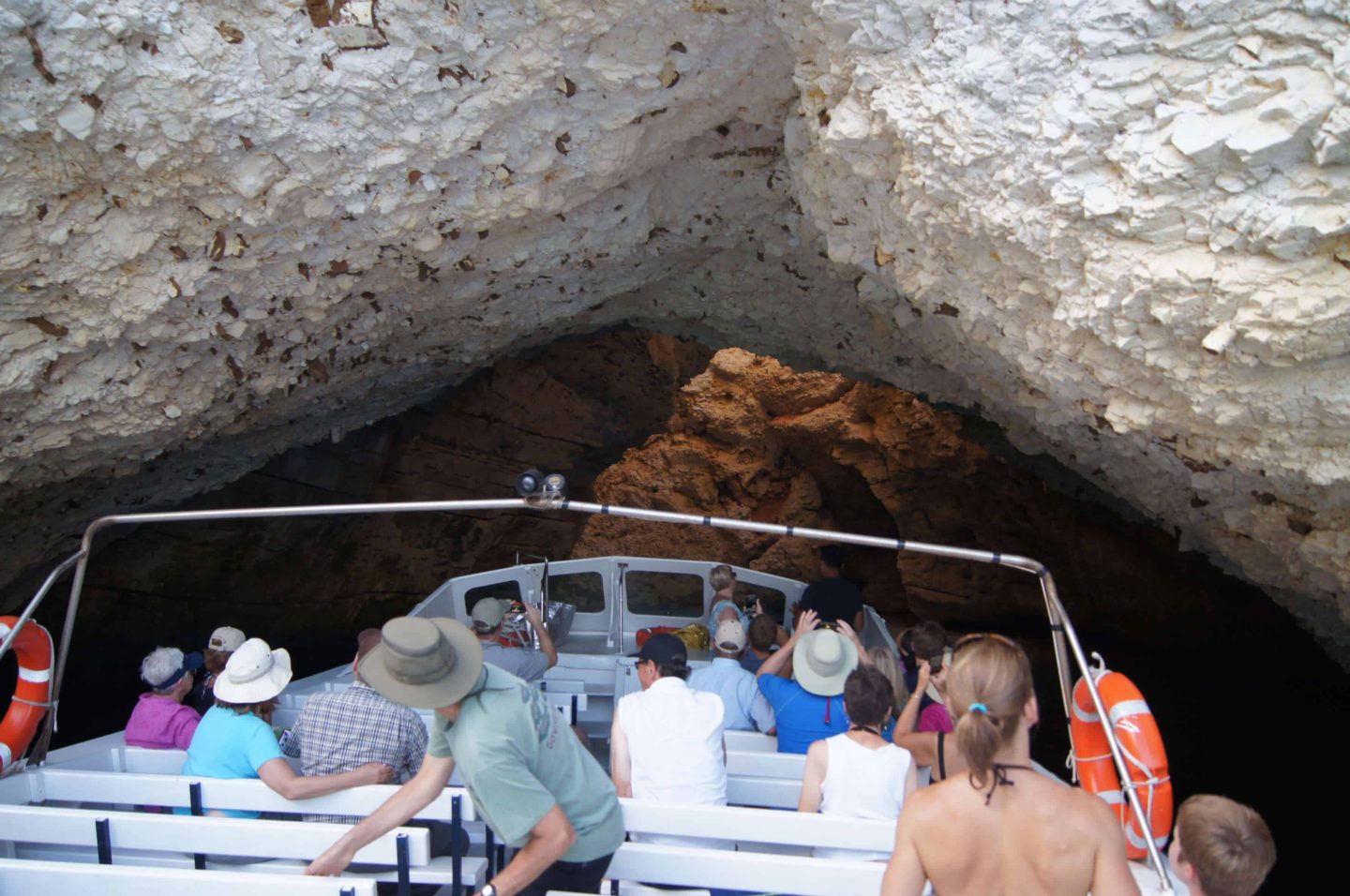
Southern Italy: Alberobello
About 45 miles east of Matera and 150 miles south of Vieste, Alberobello is the home of the Trulli, the ancient limestone structures with conical roofs. These structures used no mortar in their construction. They were simple one-room dwellings topped with religious or pagan symbols to ward off evil spirits. We learned that the Trulli were built as temporary homes to avoid the king’s taxes on permanent structures. Thus, they could be easily dismantled and moved. After touring a trullo, we visited Enoteca Tholos that has a large selection of wine, olive oil, meats, jams, cheese, pasta, and other regional products. TIP: If interested in visiting the Enoteca, contact them ahead of time to arrange a tasting.
Alberobello
Trulli dwellings in Alberobello were built without mortar, so they qualified as temporary housing. They could be easily disassembled and moved. This benefited citizens because the king, at the time, levied taxes on permanent structures.
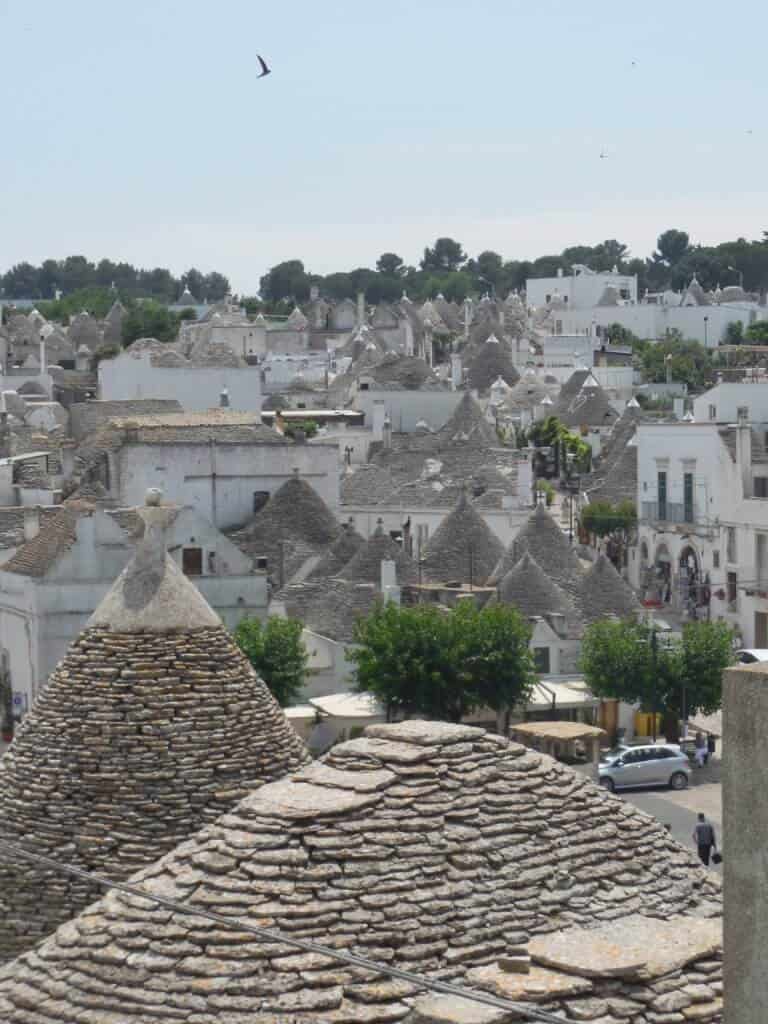
Southern Italy: Sicily
Located just off the western coast is the delightful island of Sicily. Its strategic location in the Mediterranean Sea made it a quest for conquerors over the centuries, including the Greeks, Romans, Arabs, Normans, and Italians. That mix of history has resulted in an appealing kaleidoscope of culture, food, elaborate centuries-old cathedrals, and some charming towns with narrow roads and alleys that are home to homes, restaurants, shops, and art galleries. To plan a trip to Sicily, read my article, Explore the Best of Sicily in 10 Days.
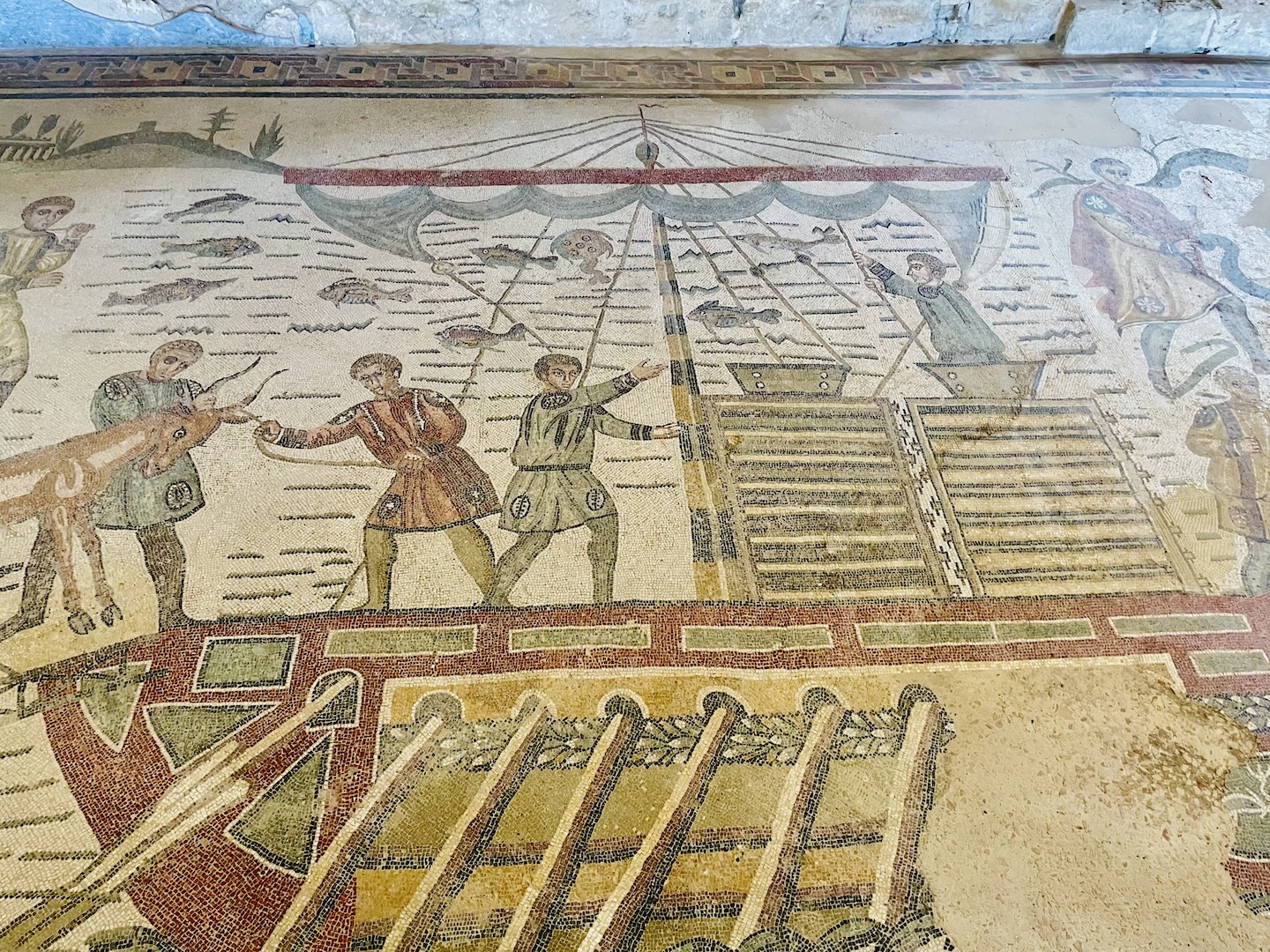
Related Articles
- Best Apps and Websites for Savvy Travelers
- Expert Tips for Traveling to Europe for More Fun, Less Stress
- Google Translate Guide for Travelers
- Top 10 Tips for Driving in Europe
- Top 10 Tips for Renting a Car in Europe
- Travel Planning Timeline
Final Thoughts
Italy holds a special place in our hearts because of the magnificent places we visited and the wonderful people we met. And, of course, we can’t forget all the delicious food and wine we enjoyed. The northern, central, and southern areas of Italy vary a great deal. Each region holds its own special charms. It’s hard to visit them all in one trip, but consider several sojourns to this very special European country.
To remember all the great experiences on your next trip, take lots of pictures and create a photo book of your journey when you return home. You’ll be glad you did!
Comments?
Feel free to share your ideas and suggestions for visiting Italy. Your thoughts could help other travelers. Thanks! 🙂

